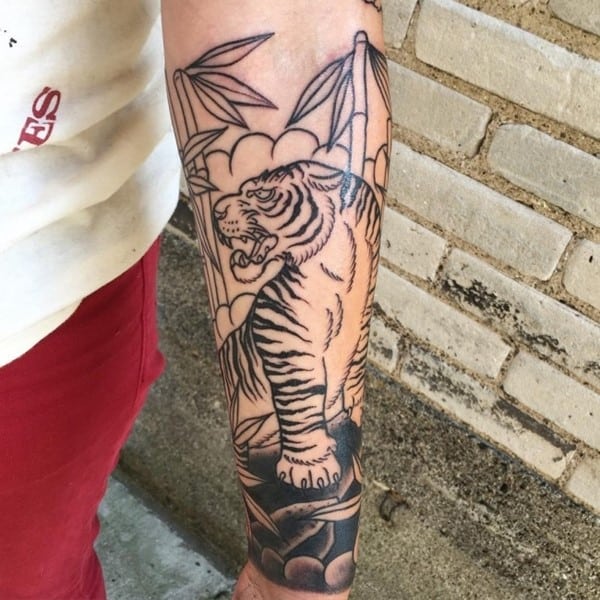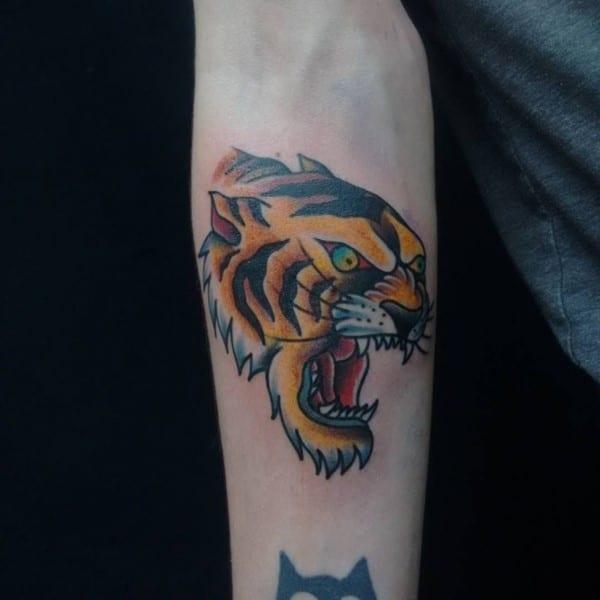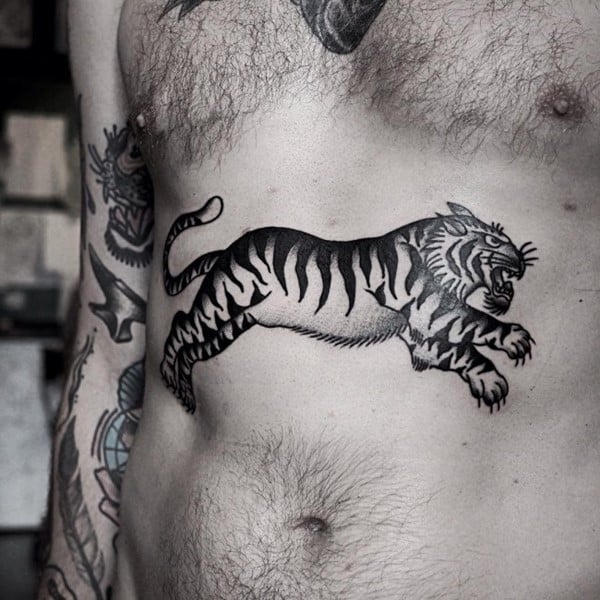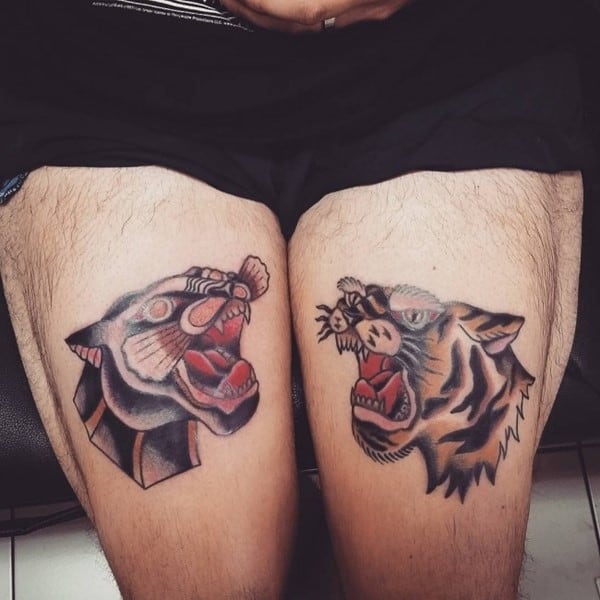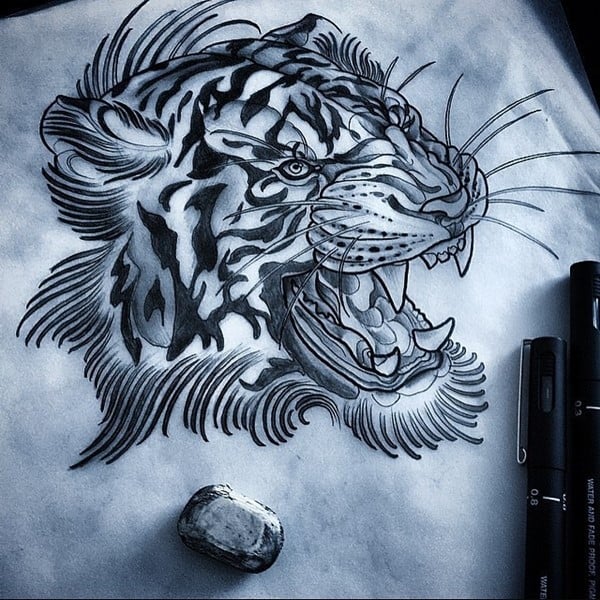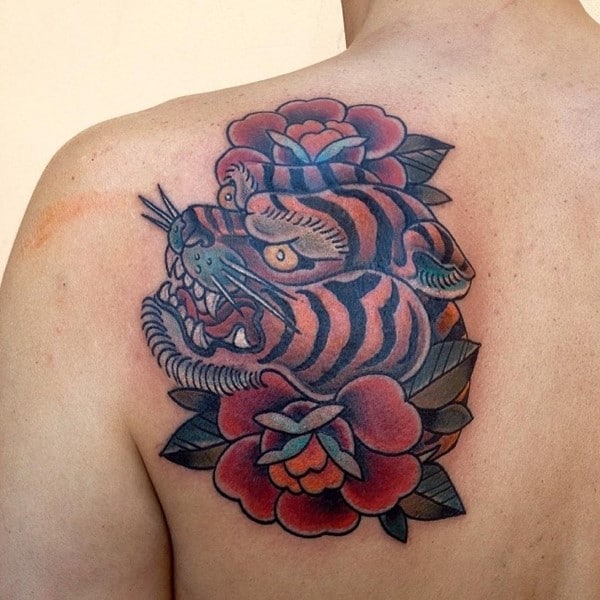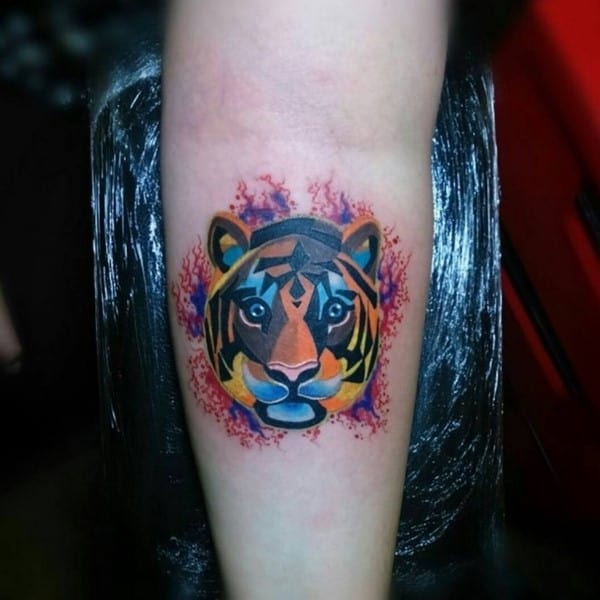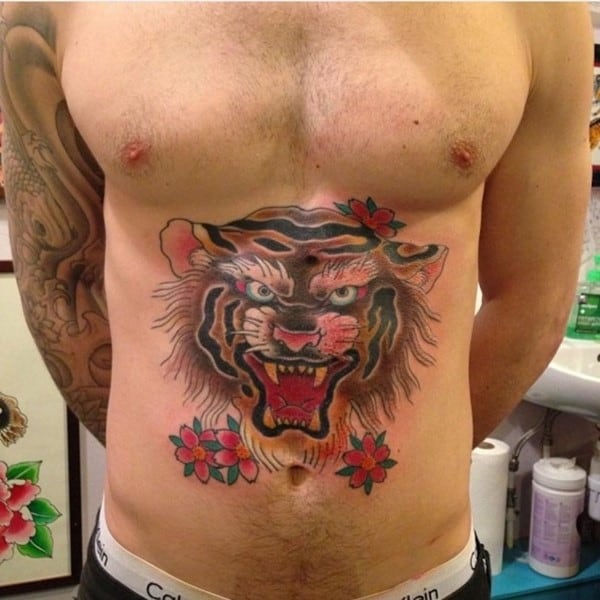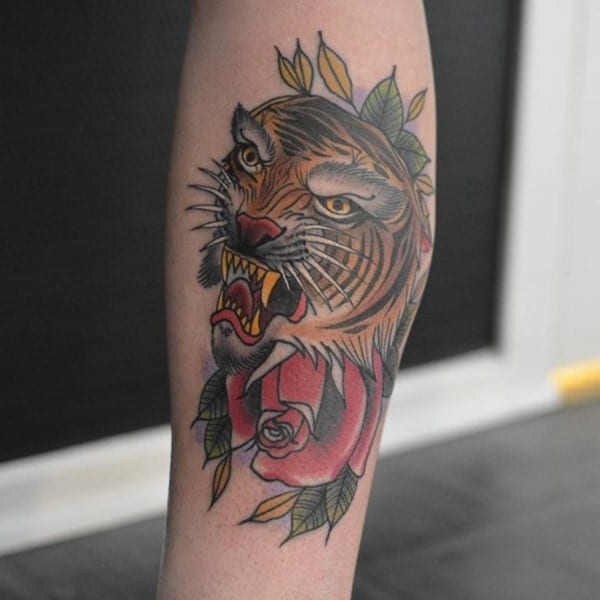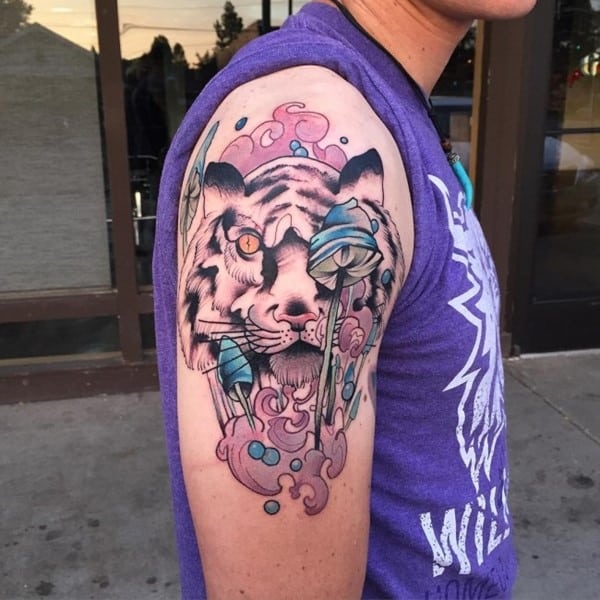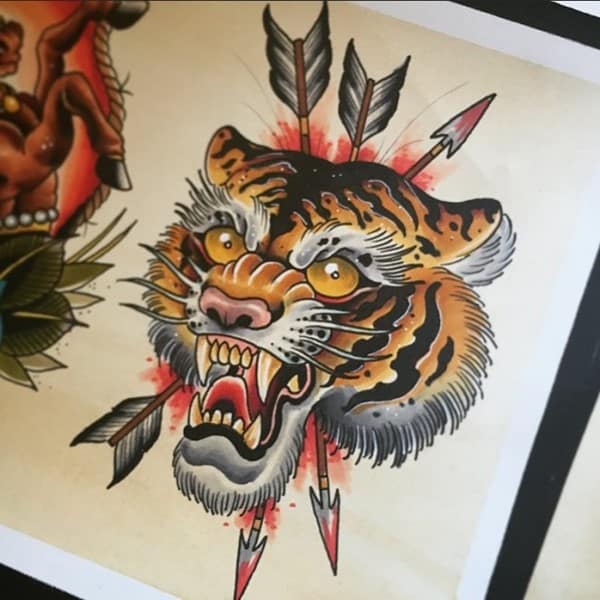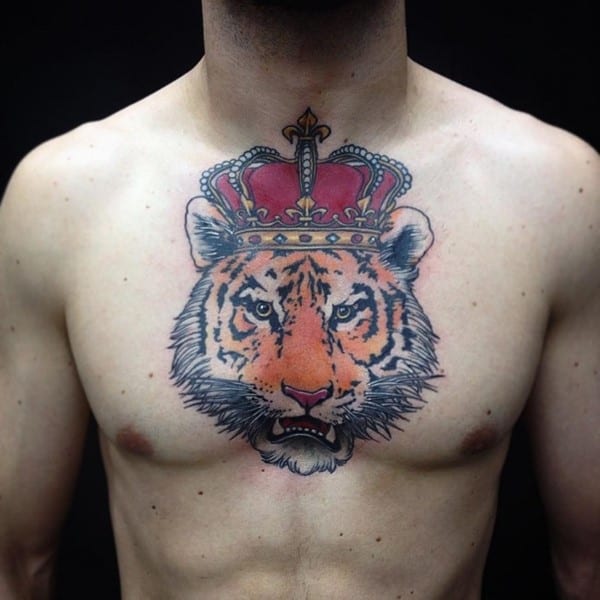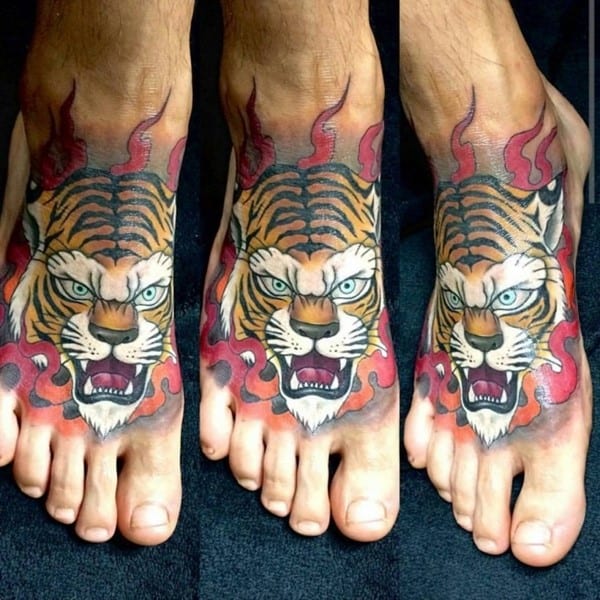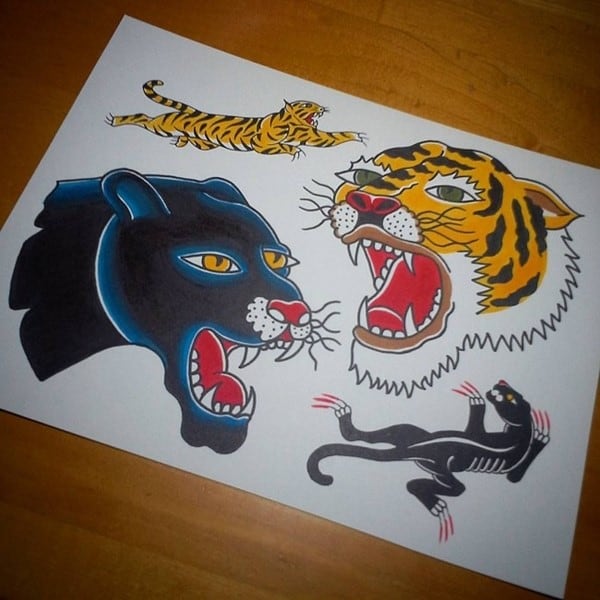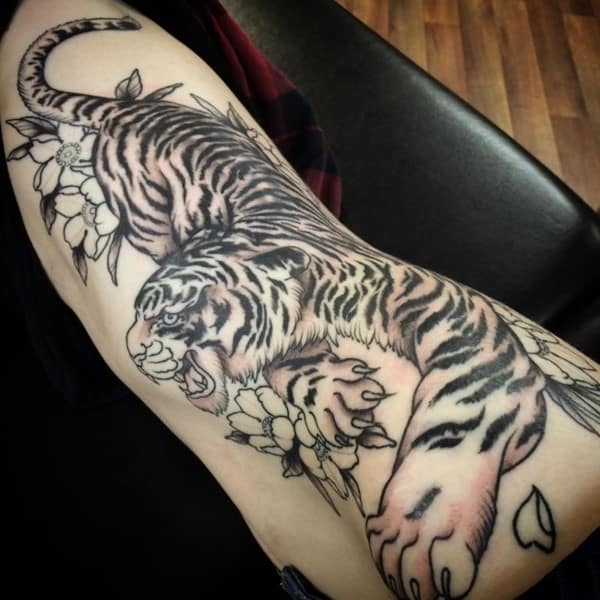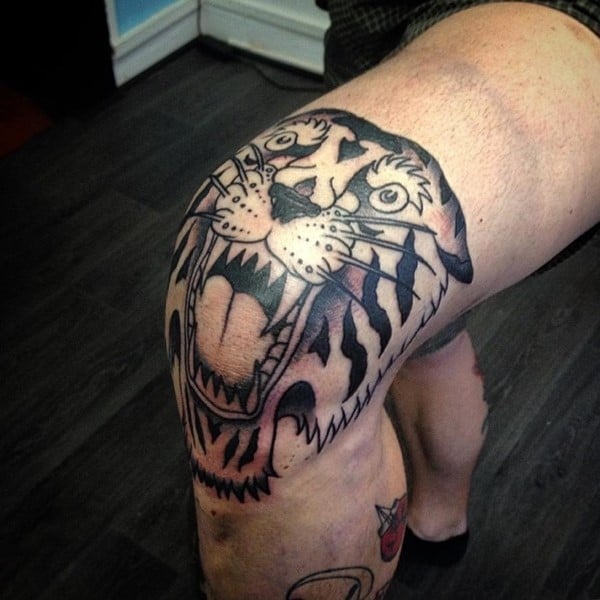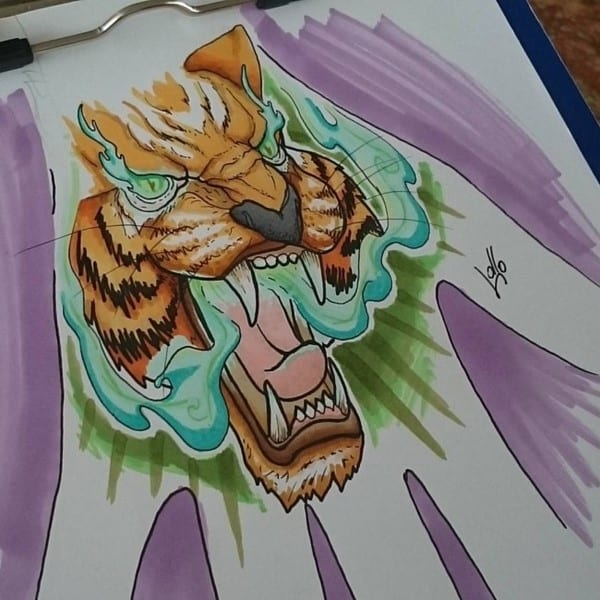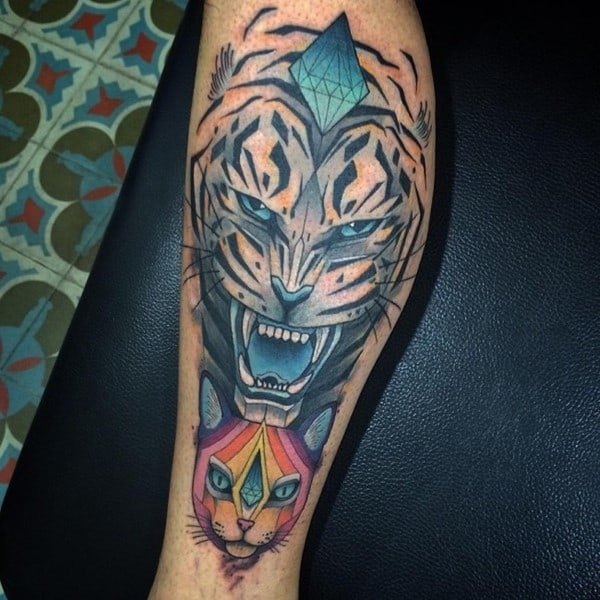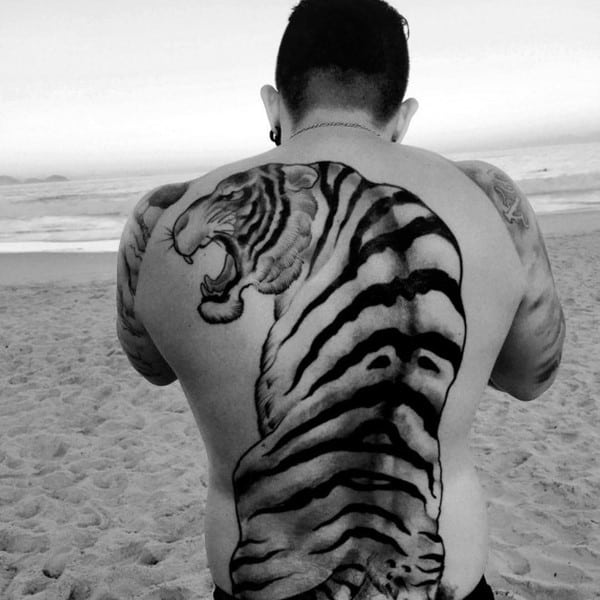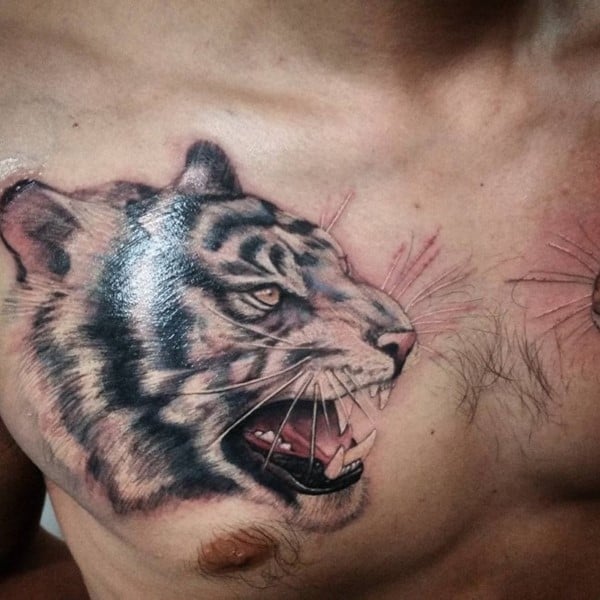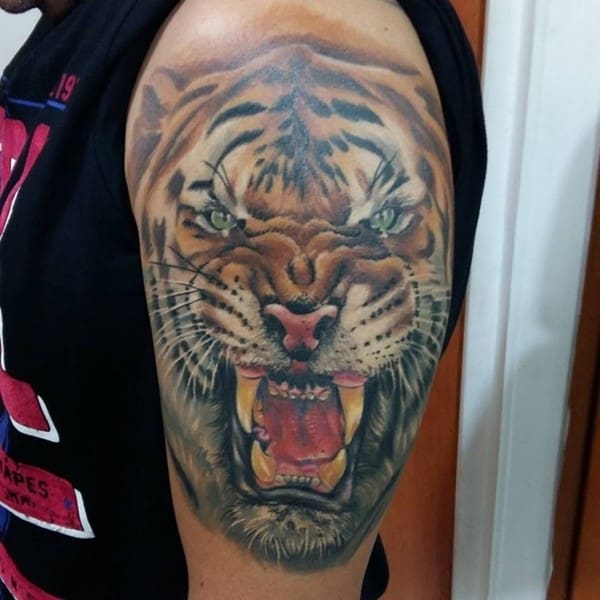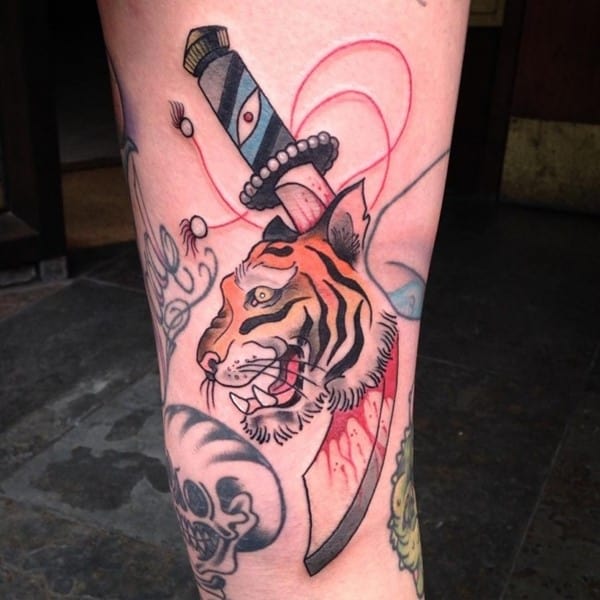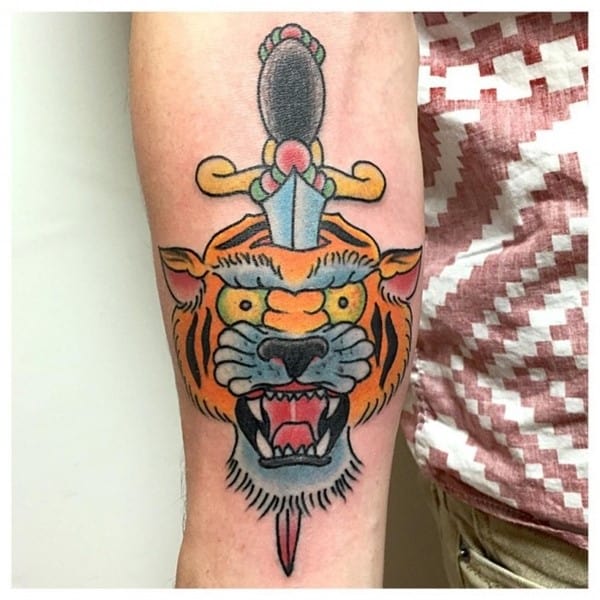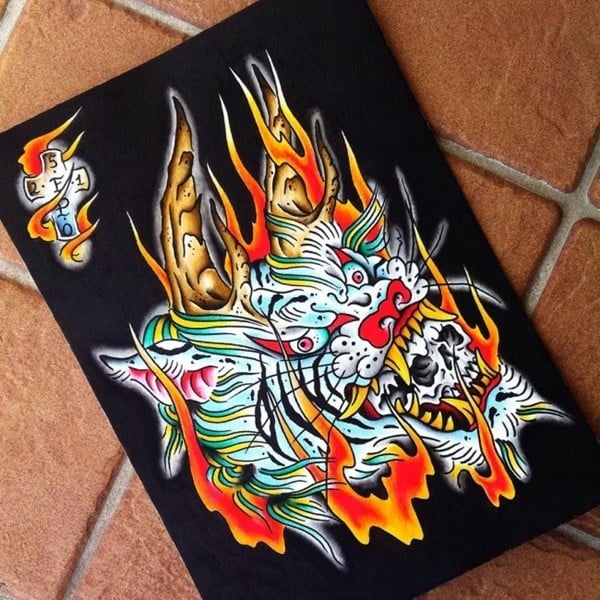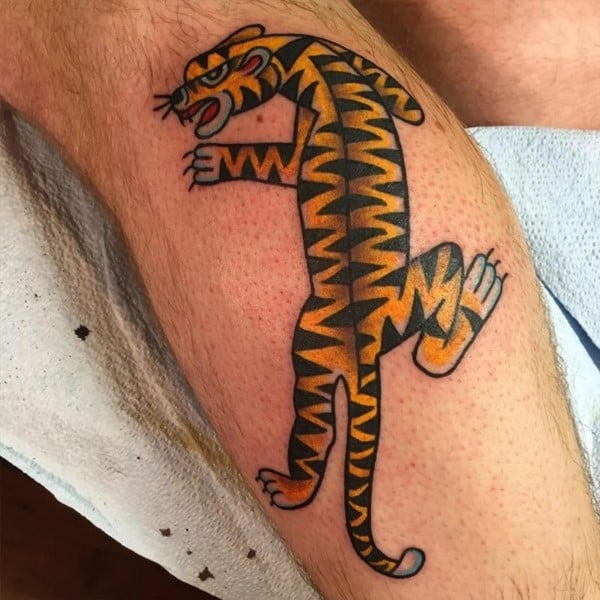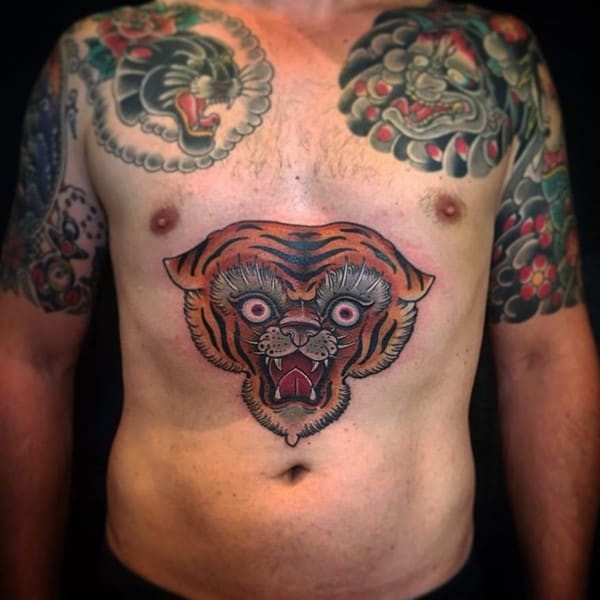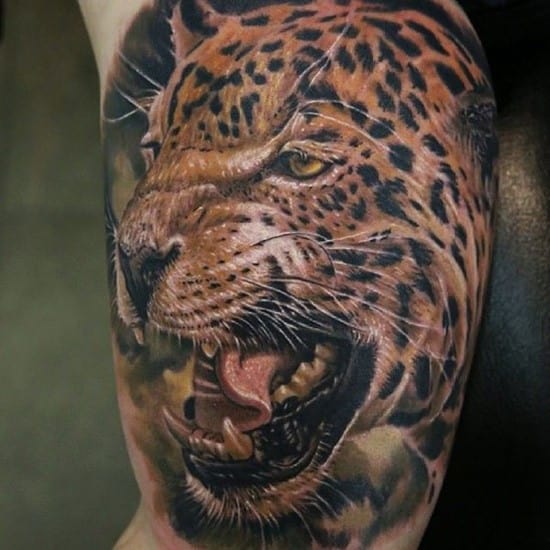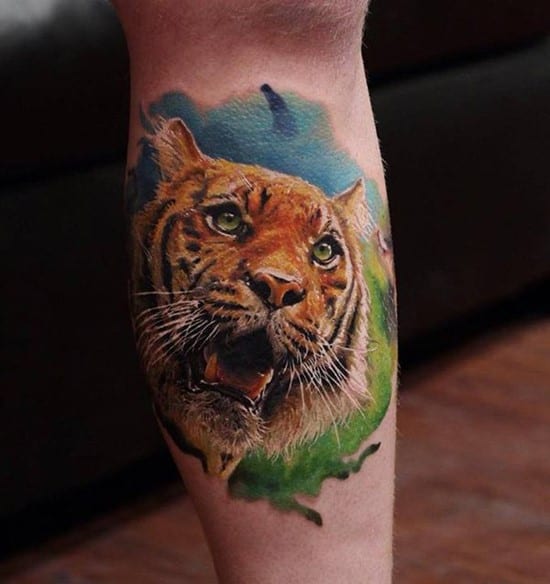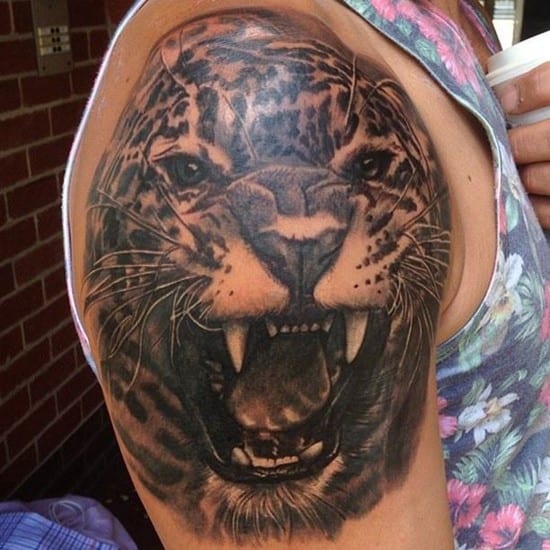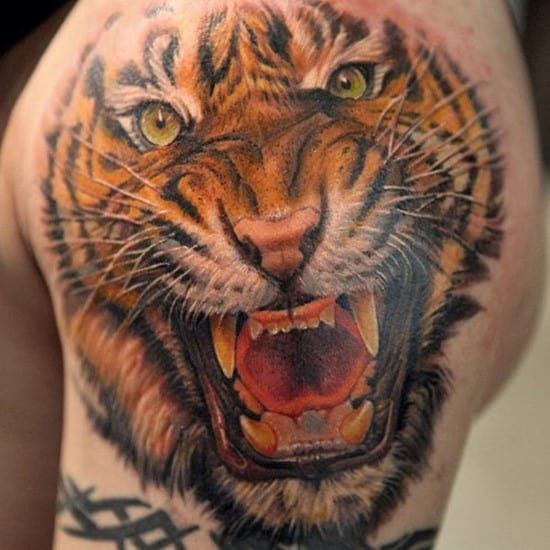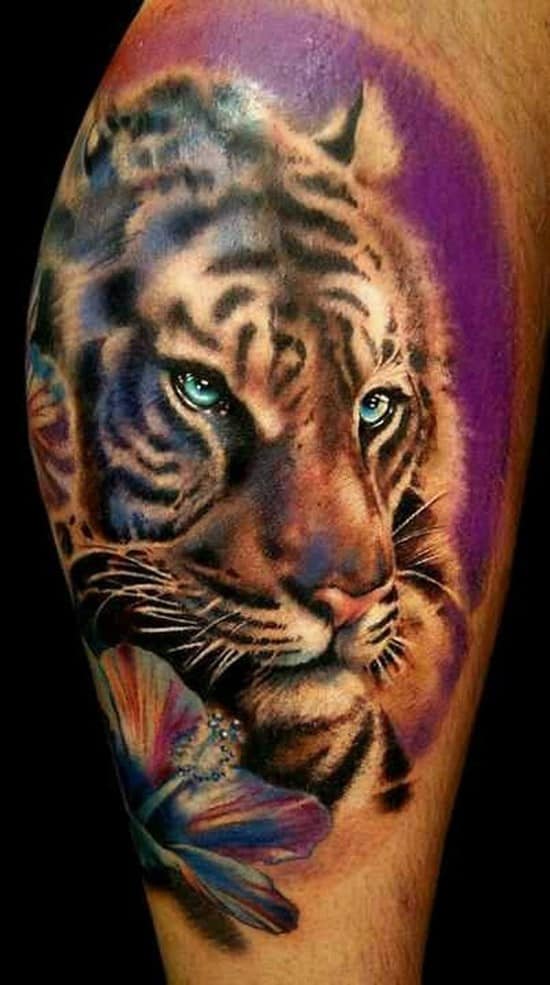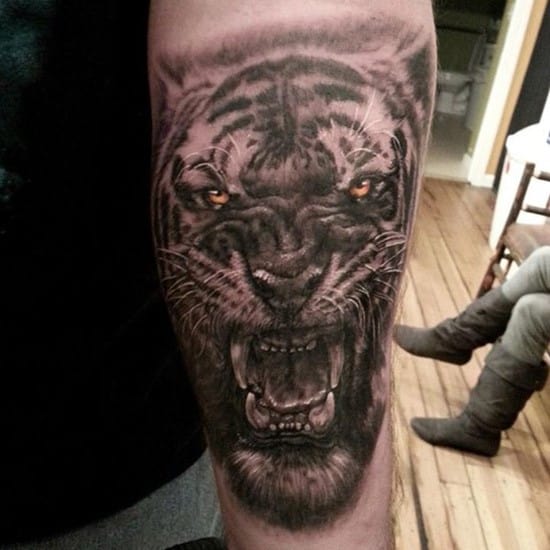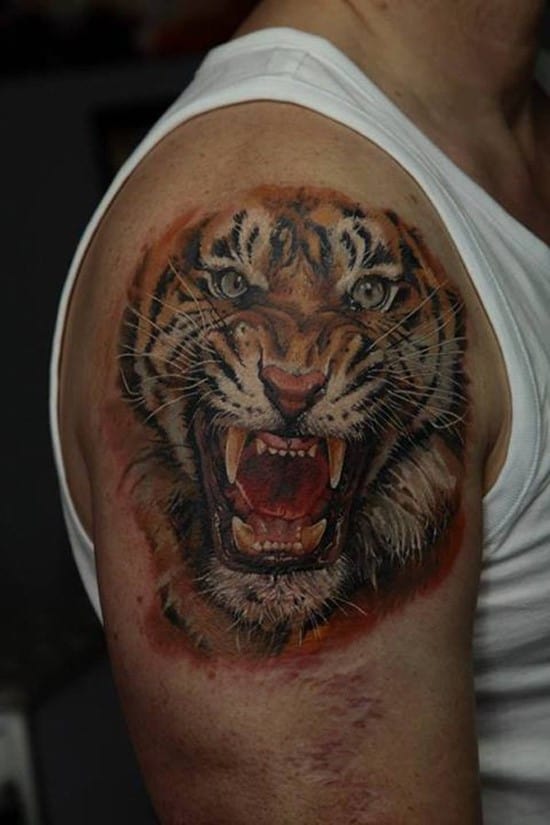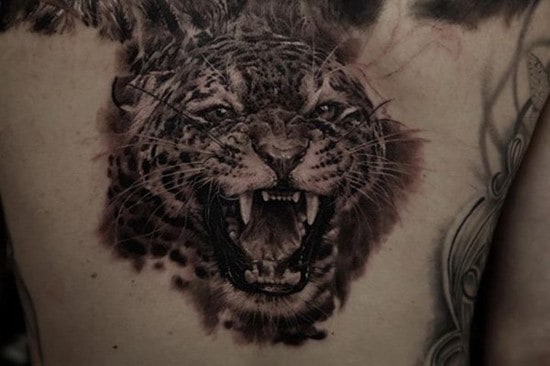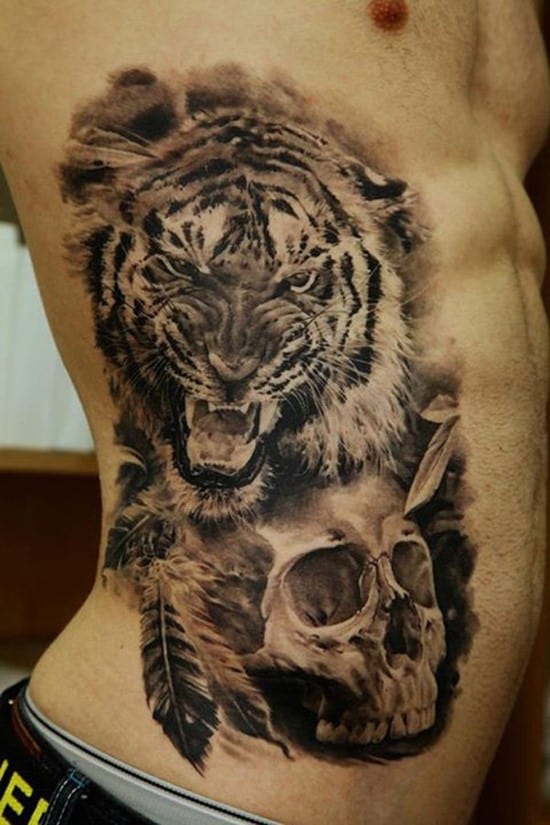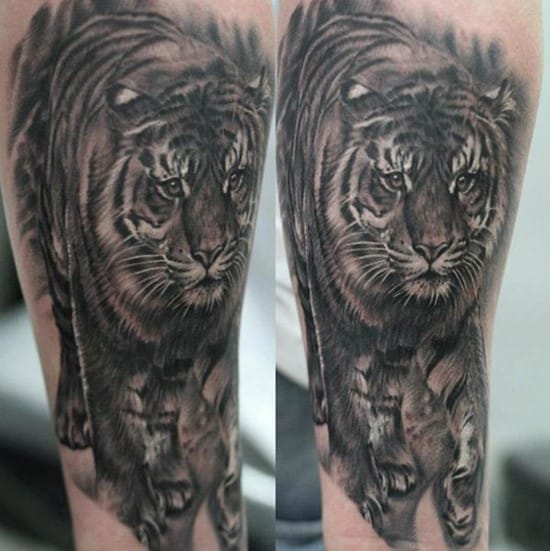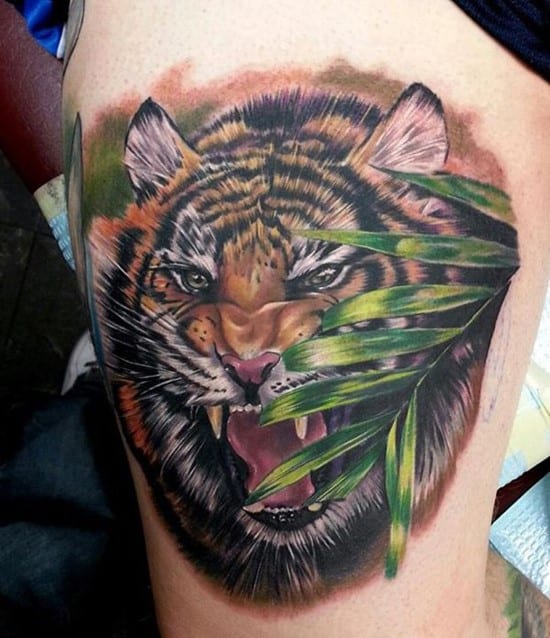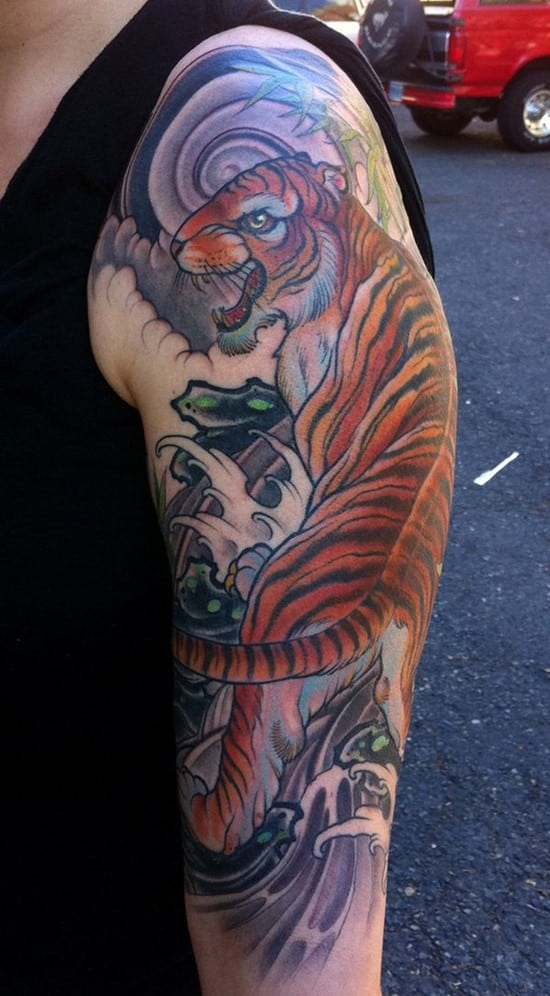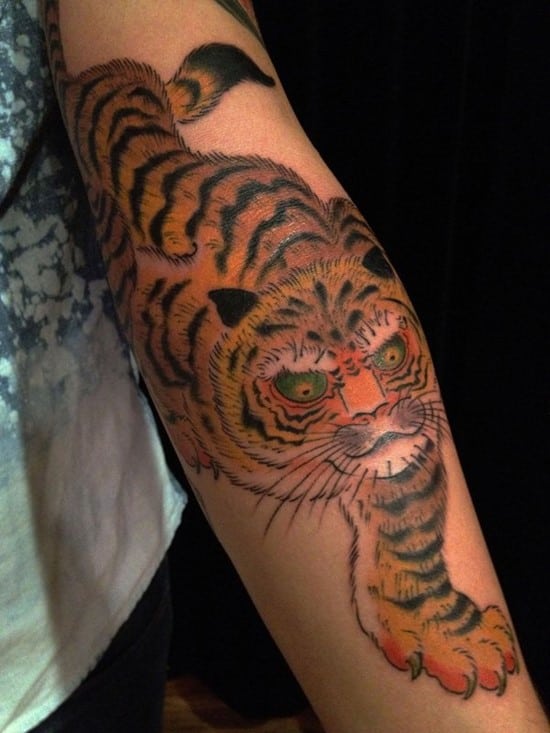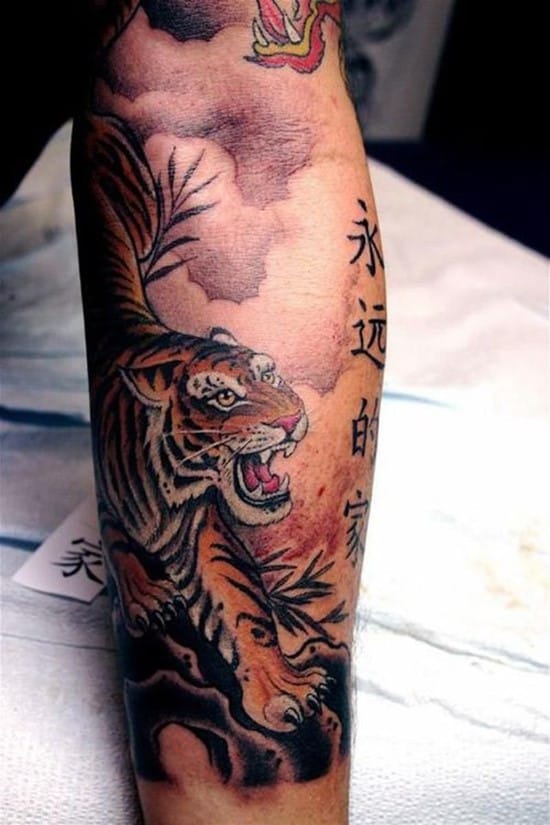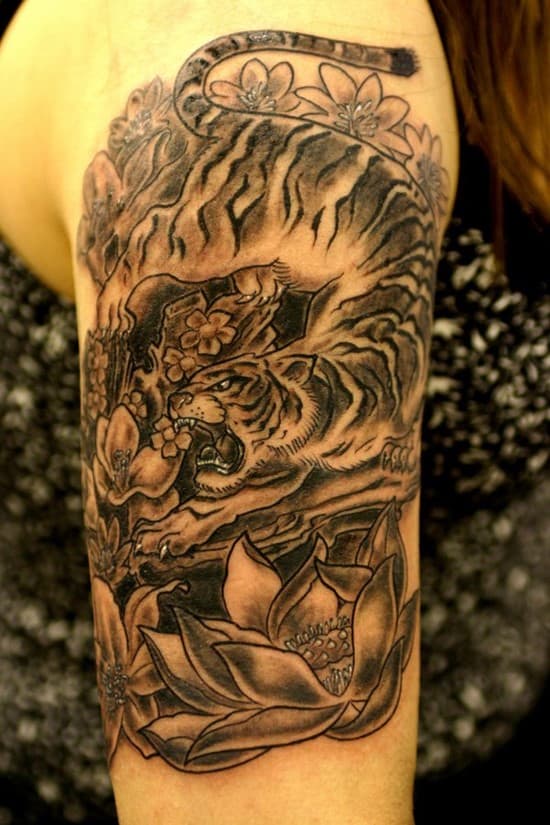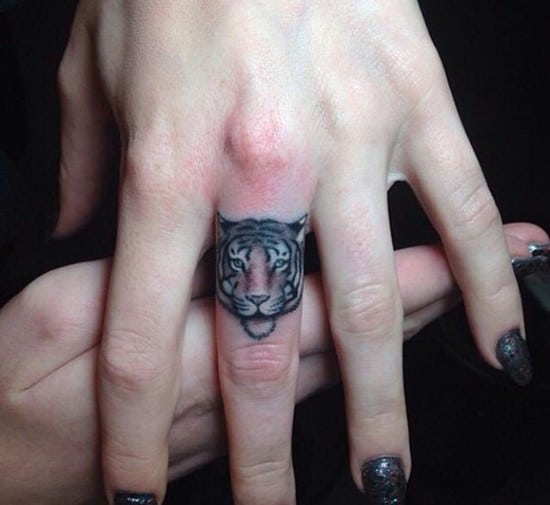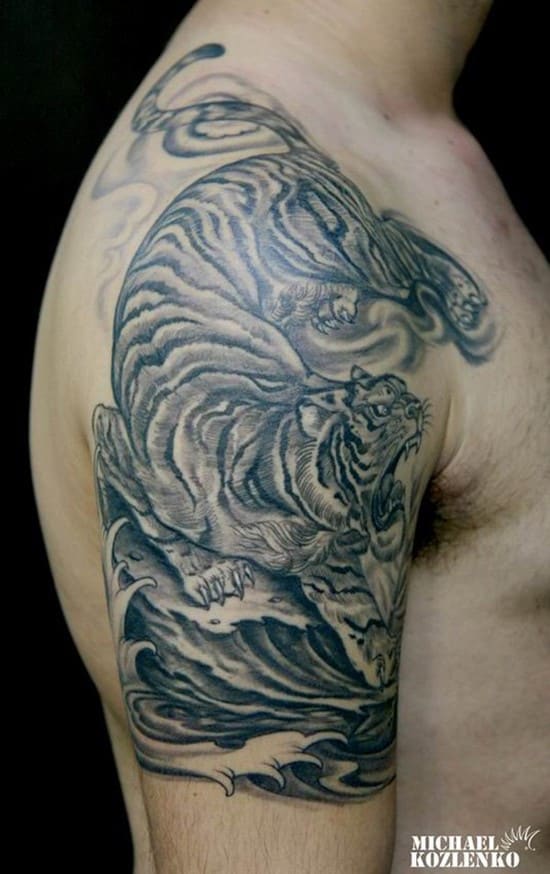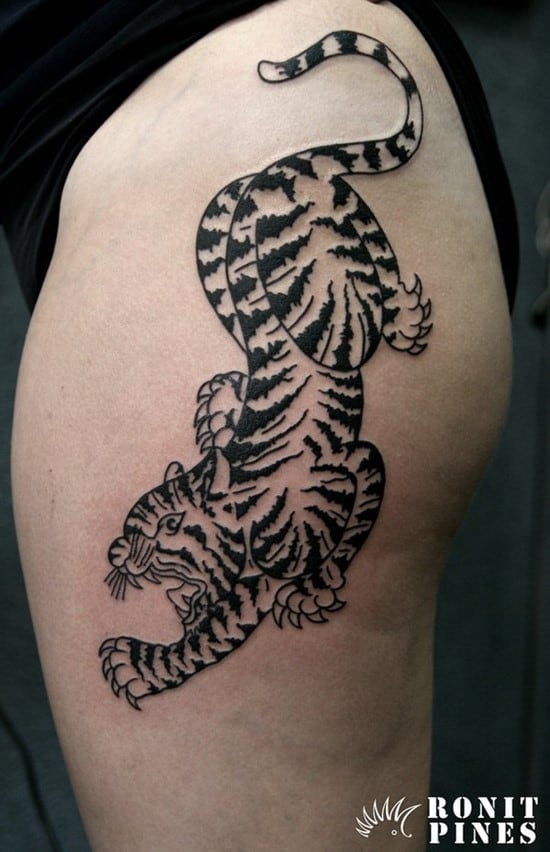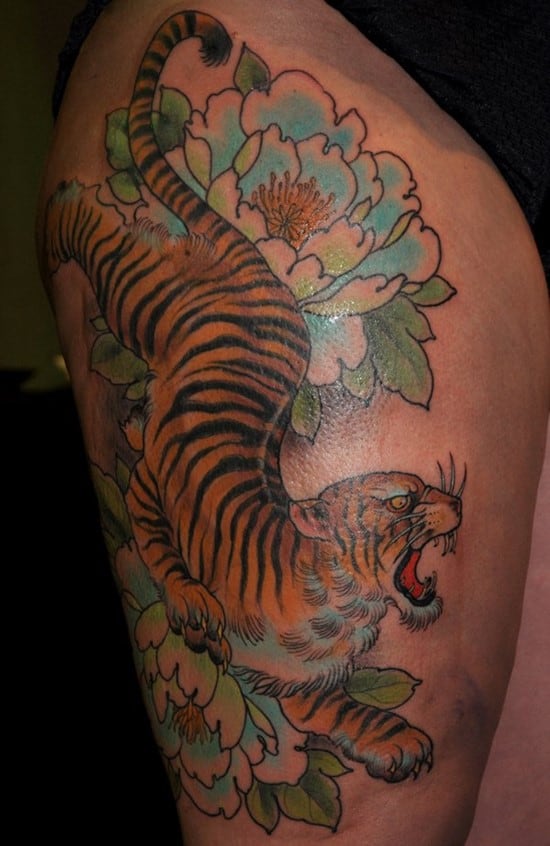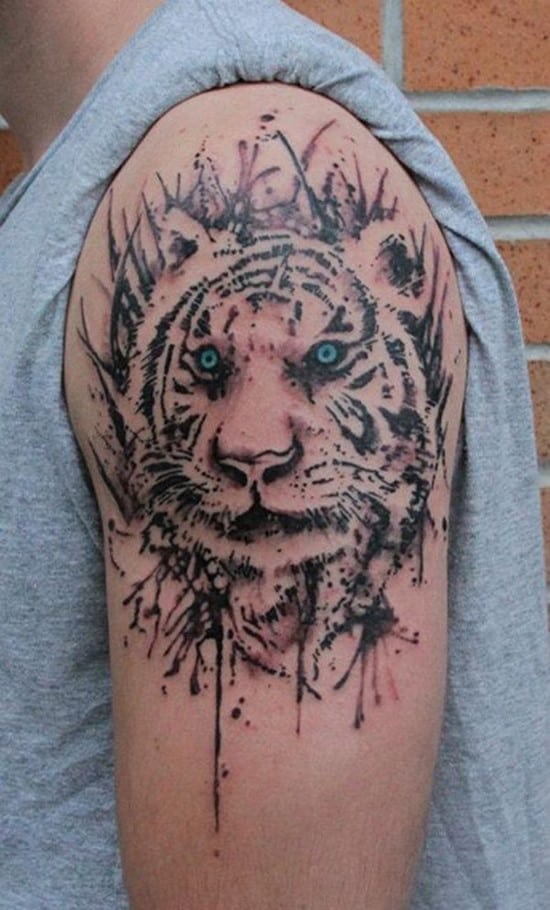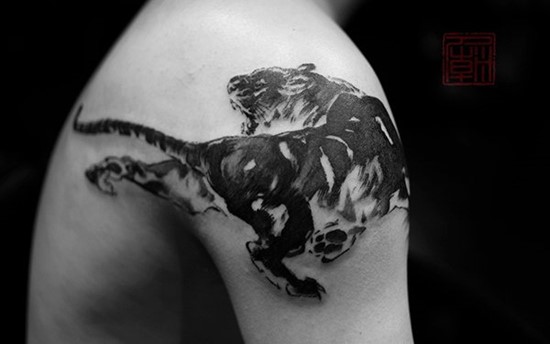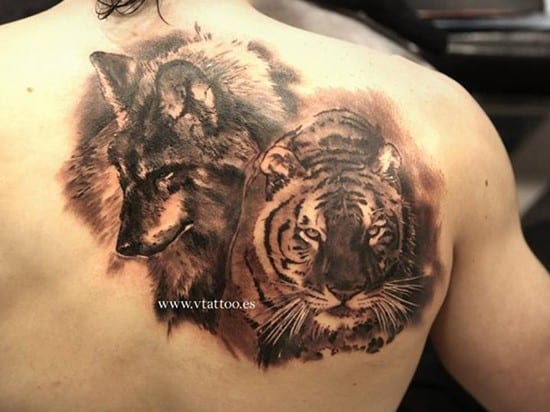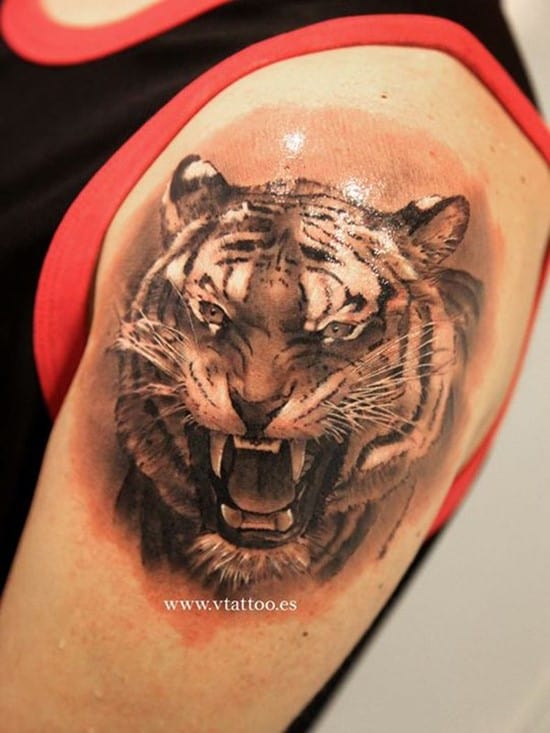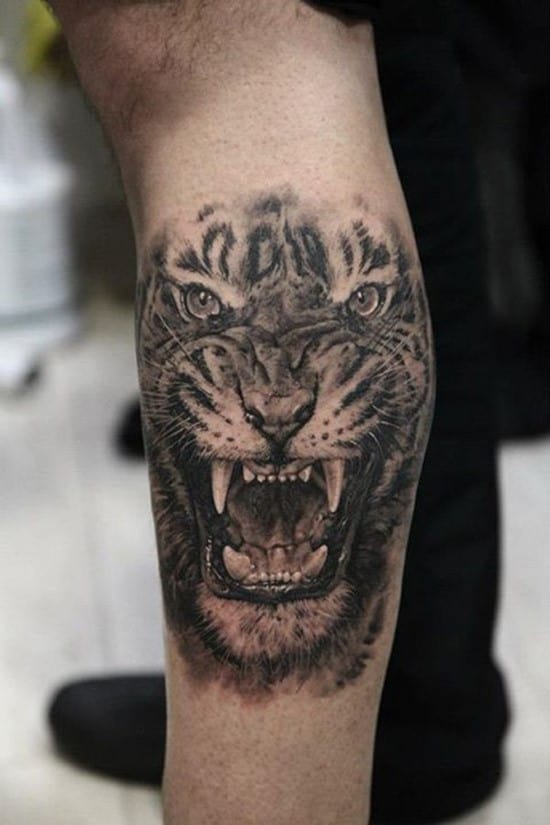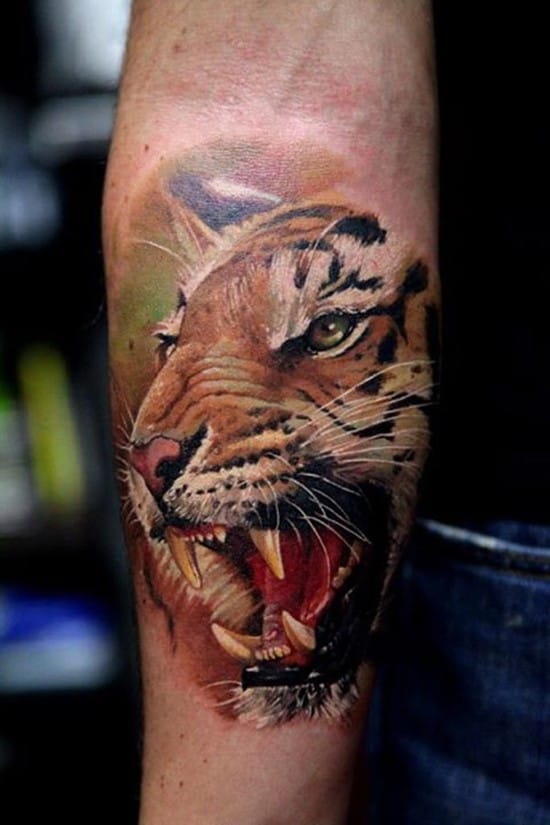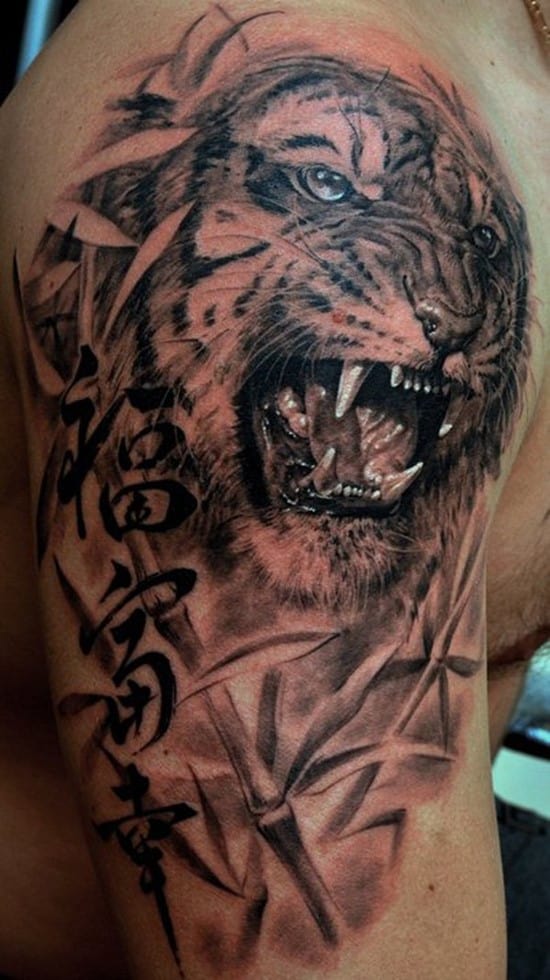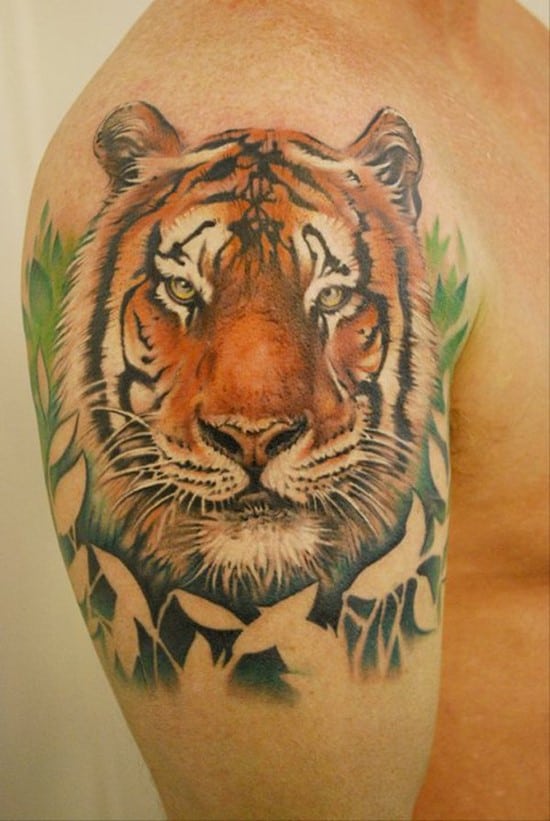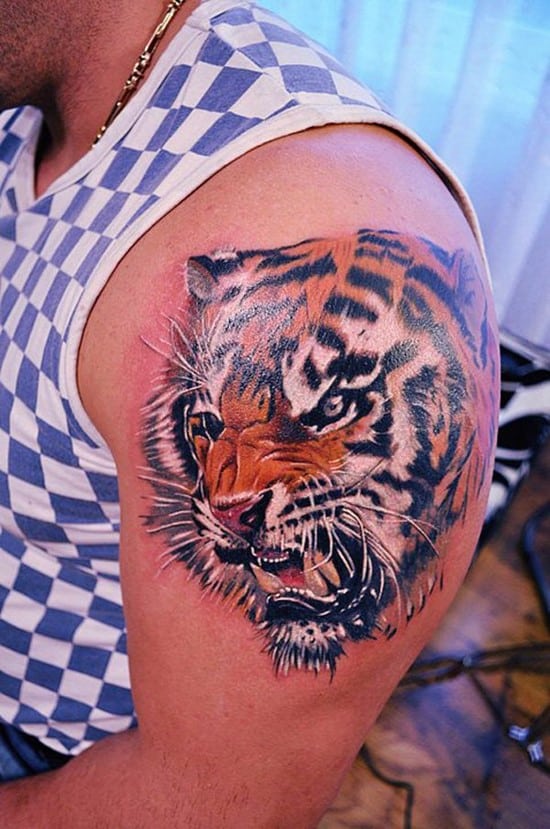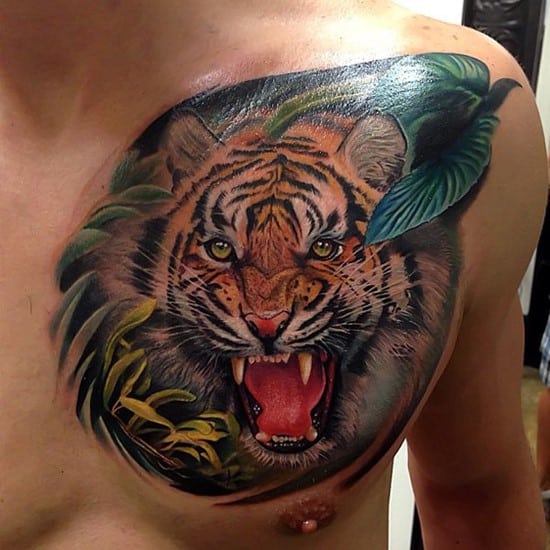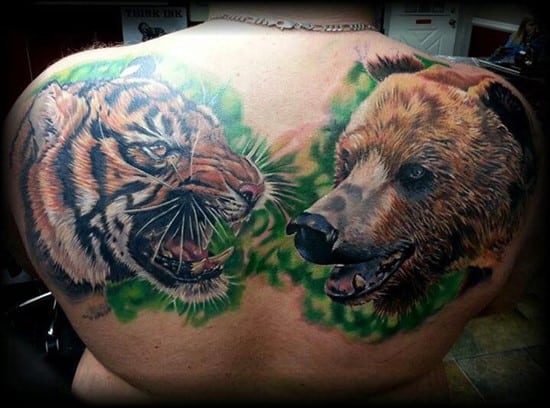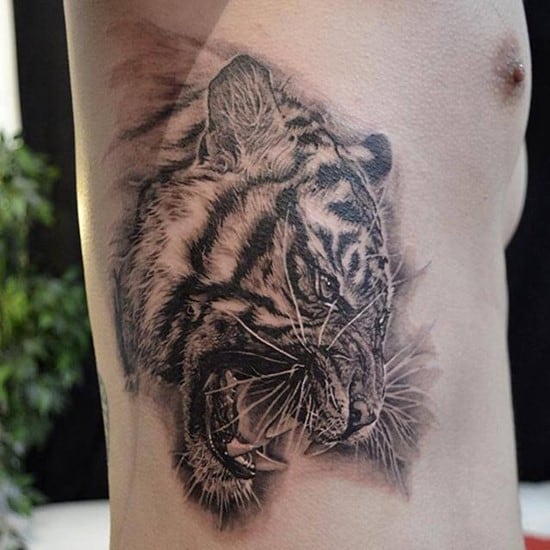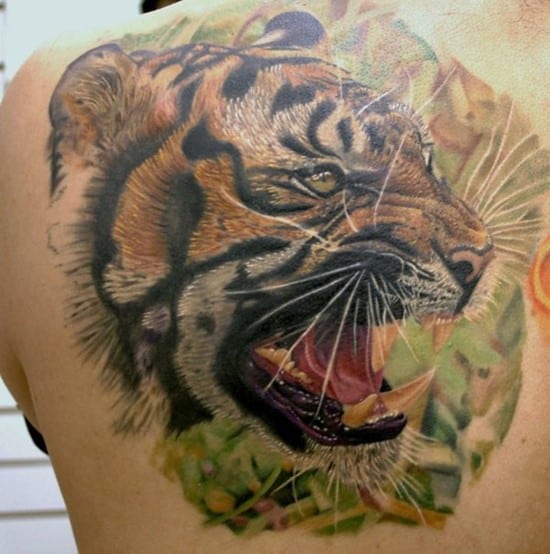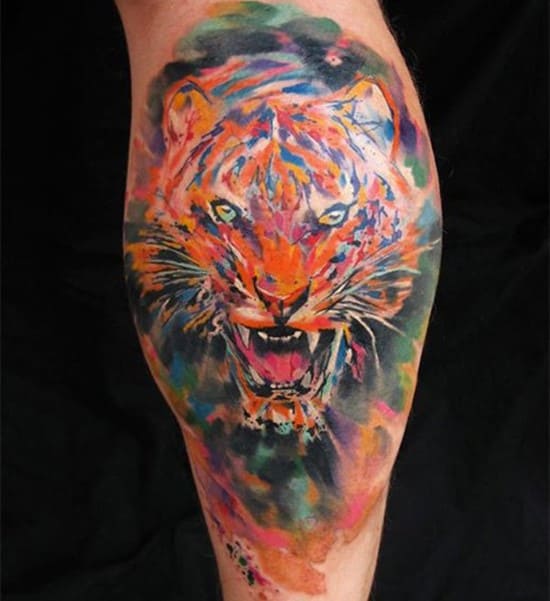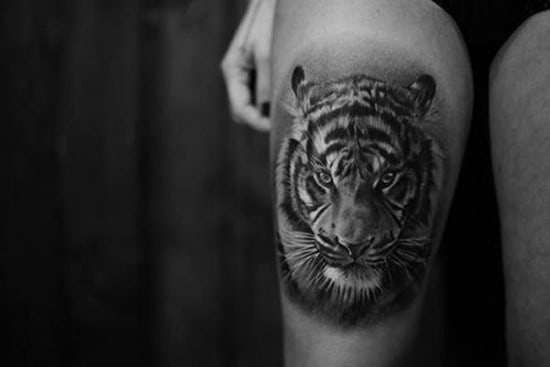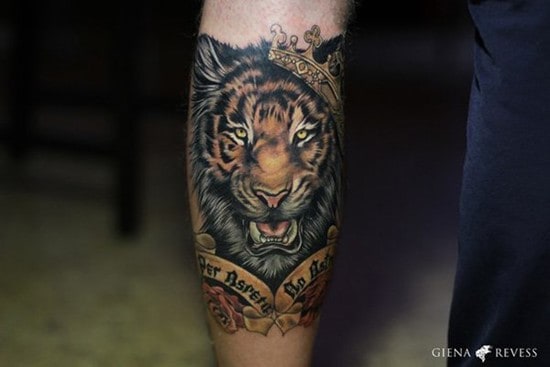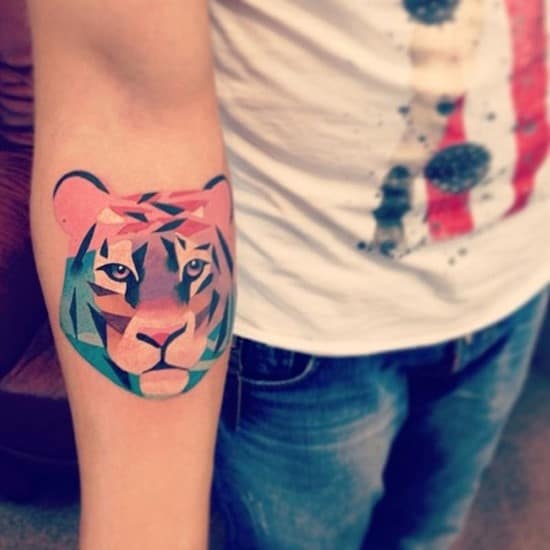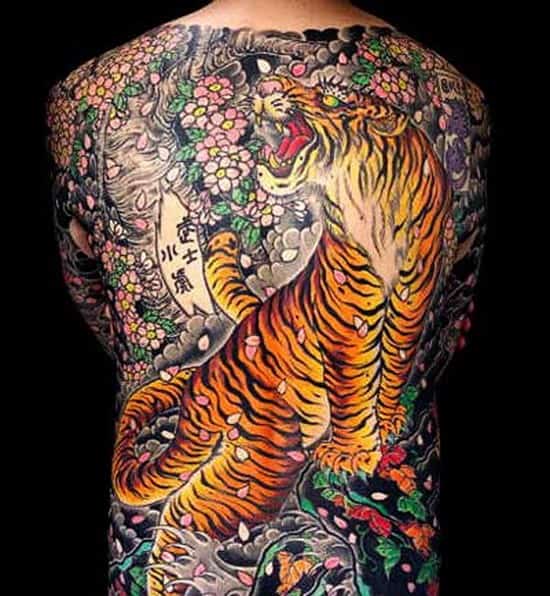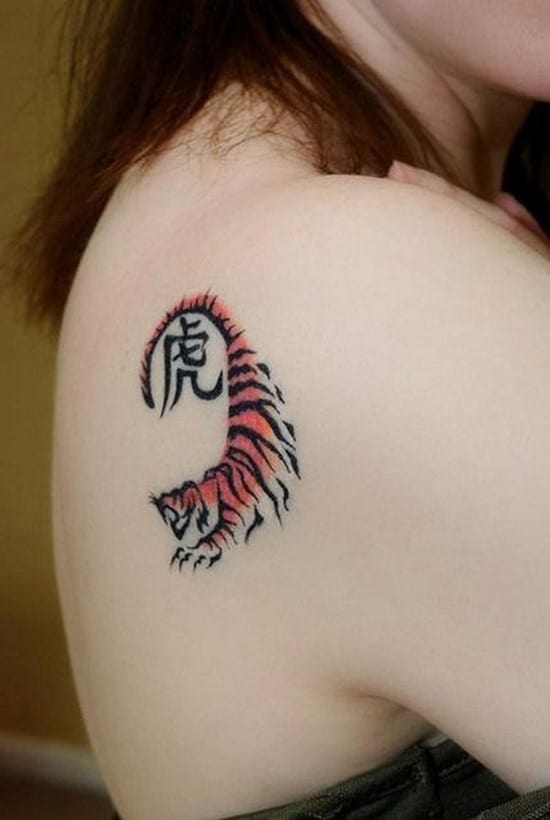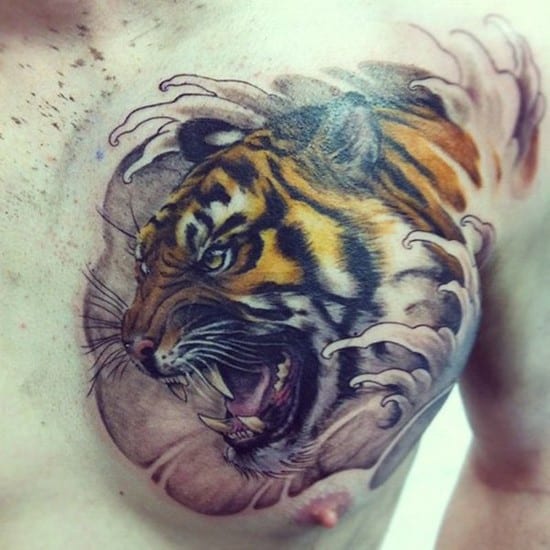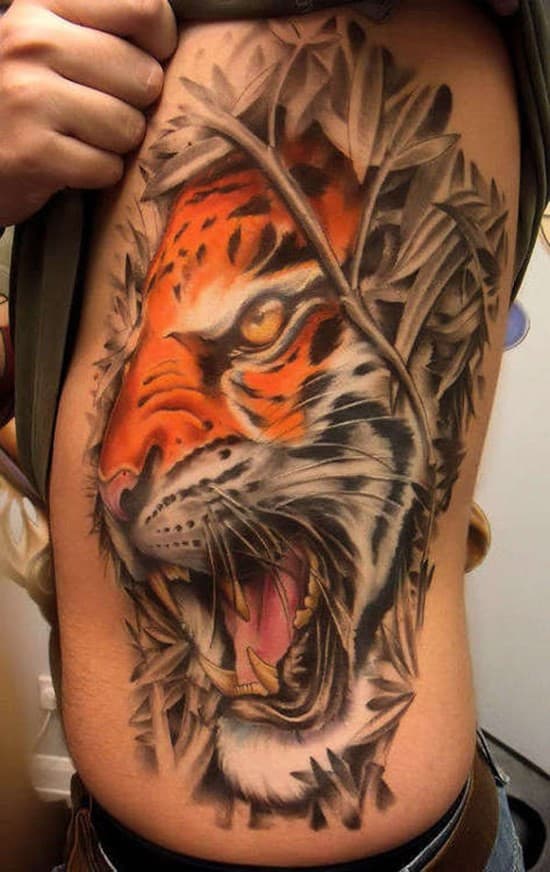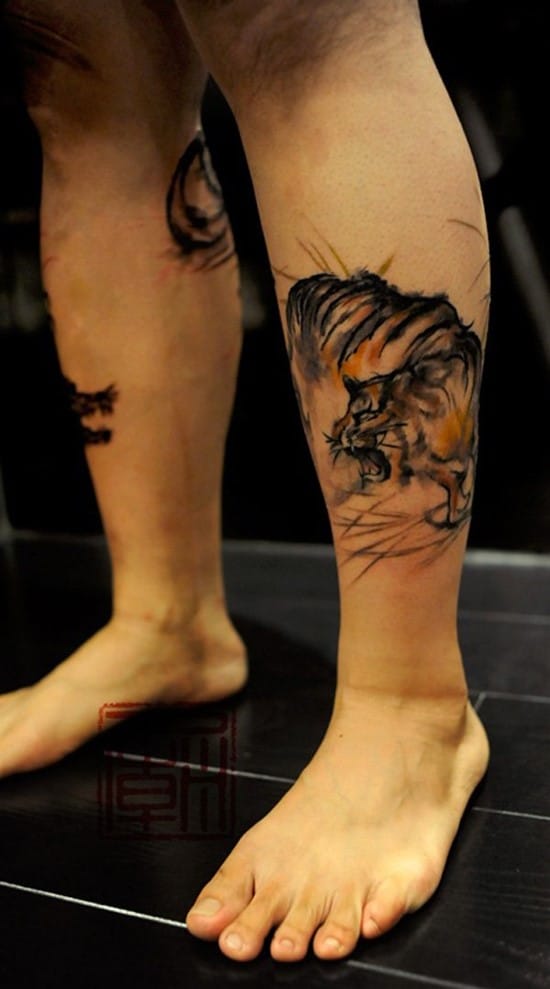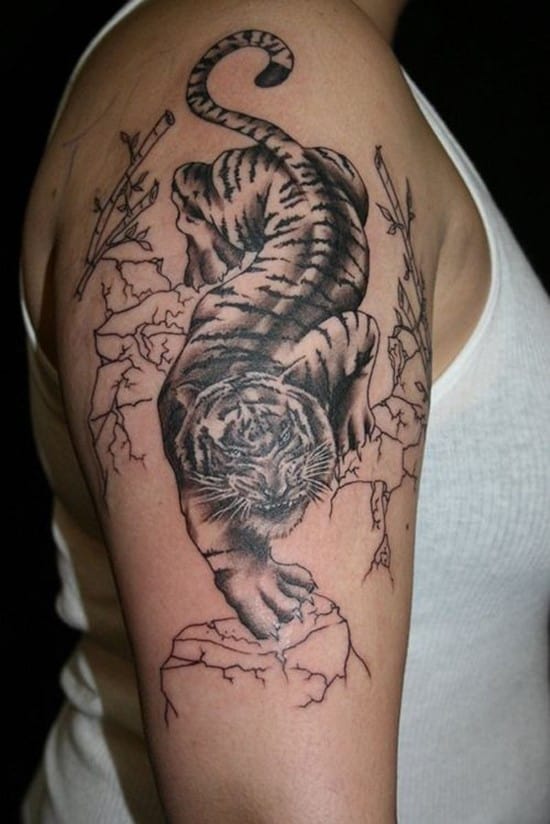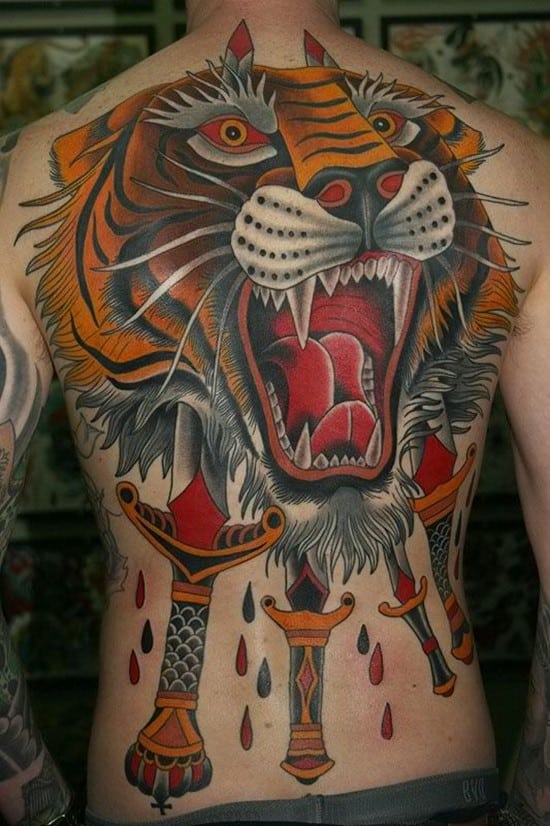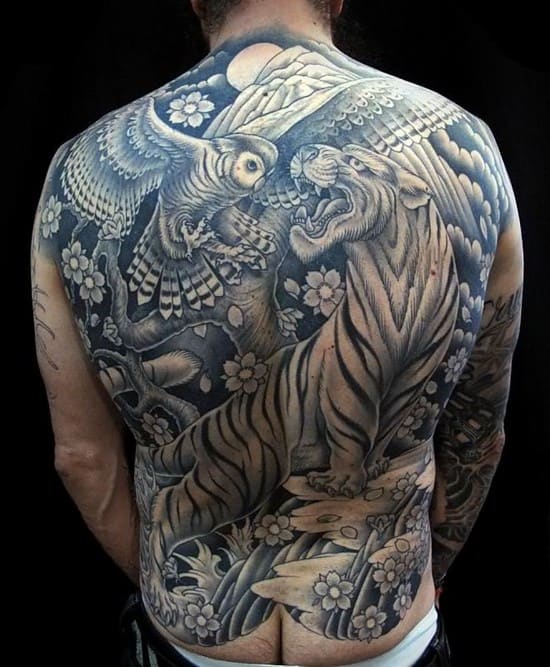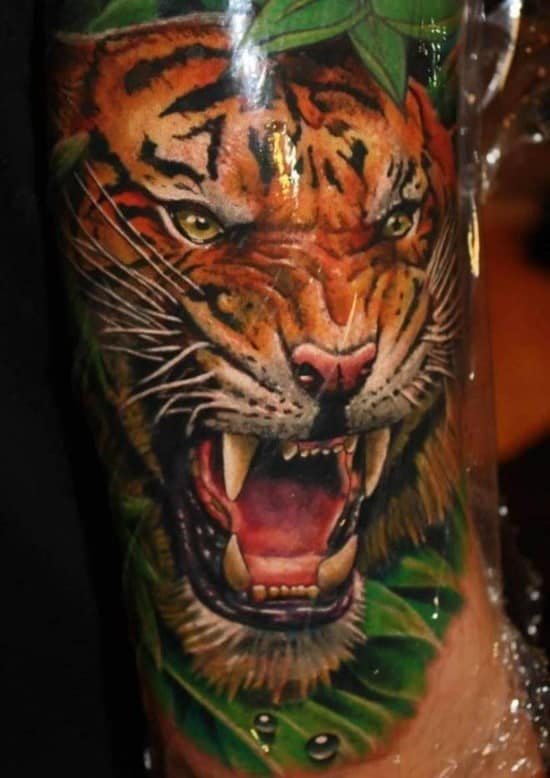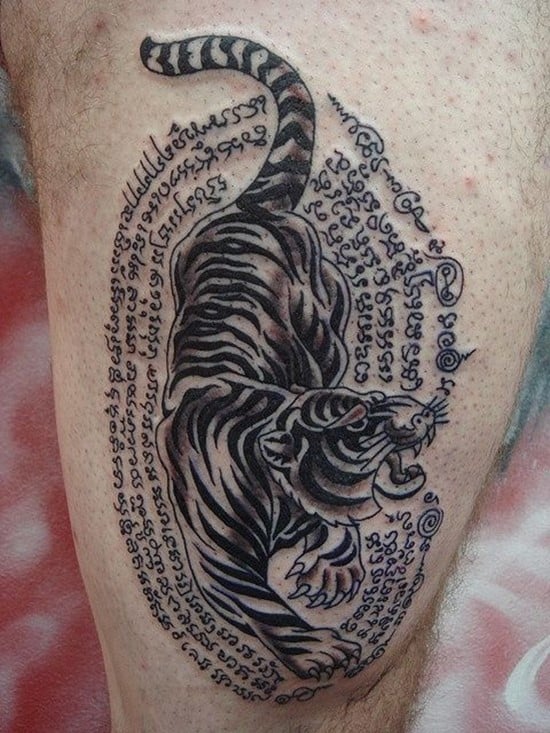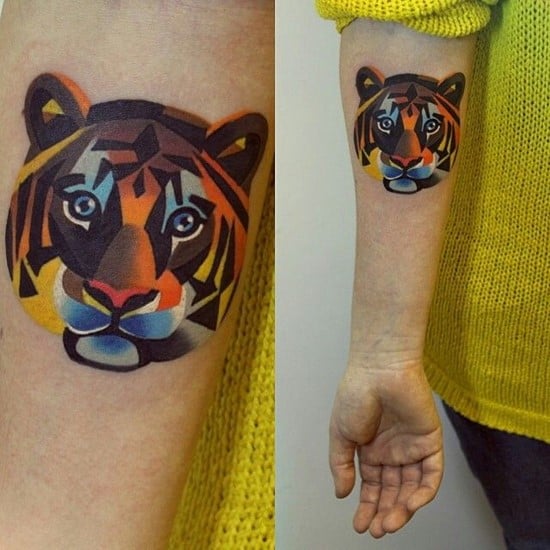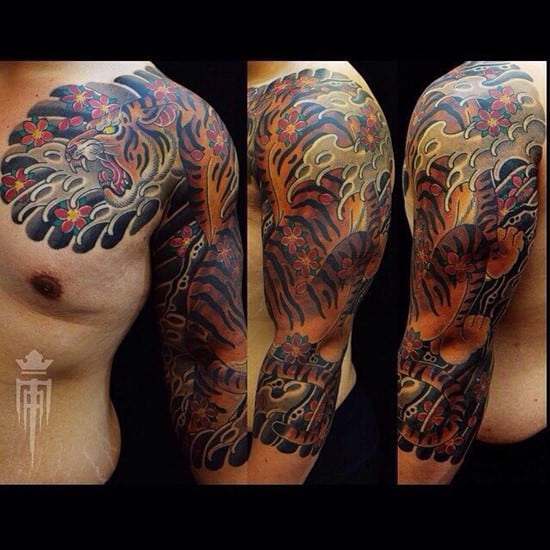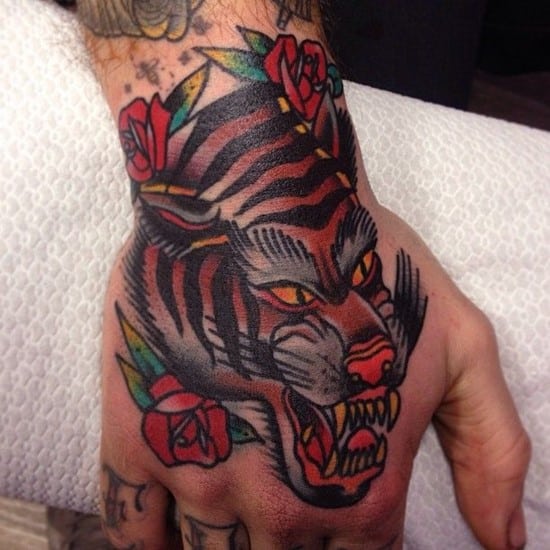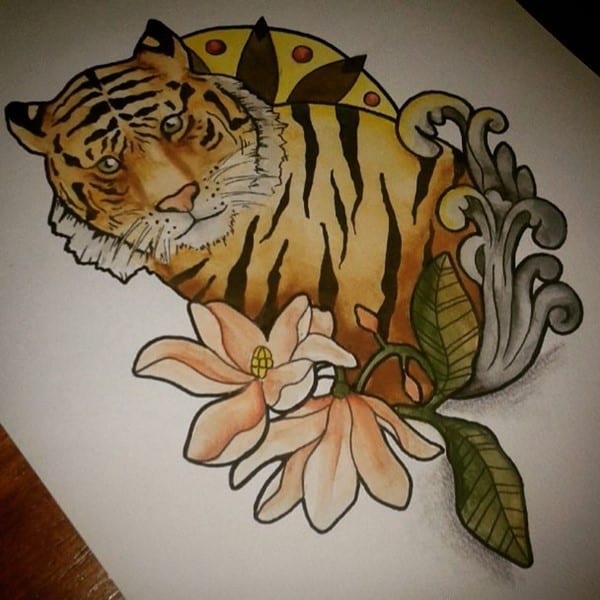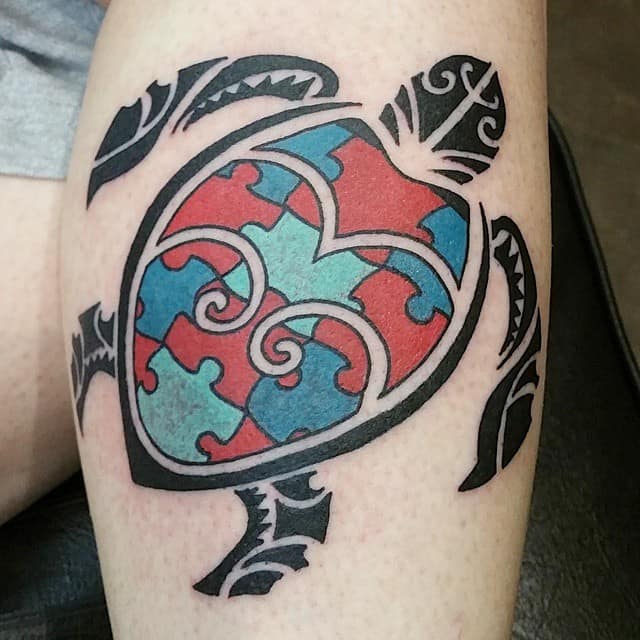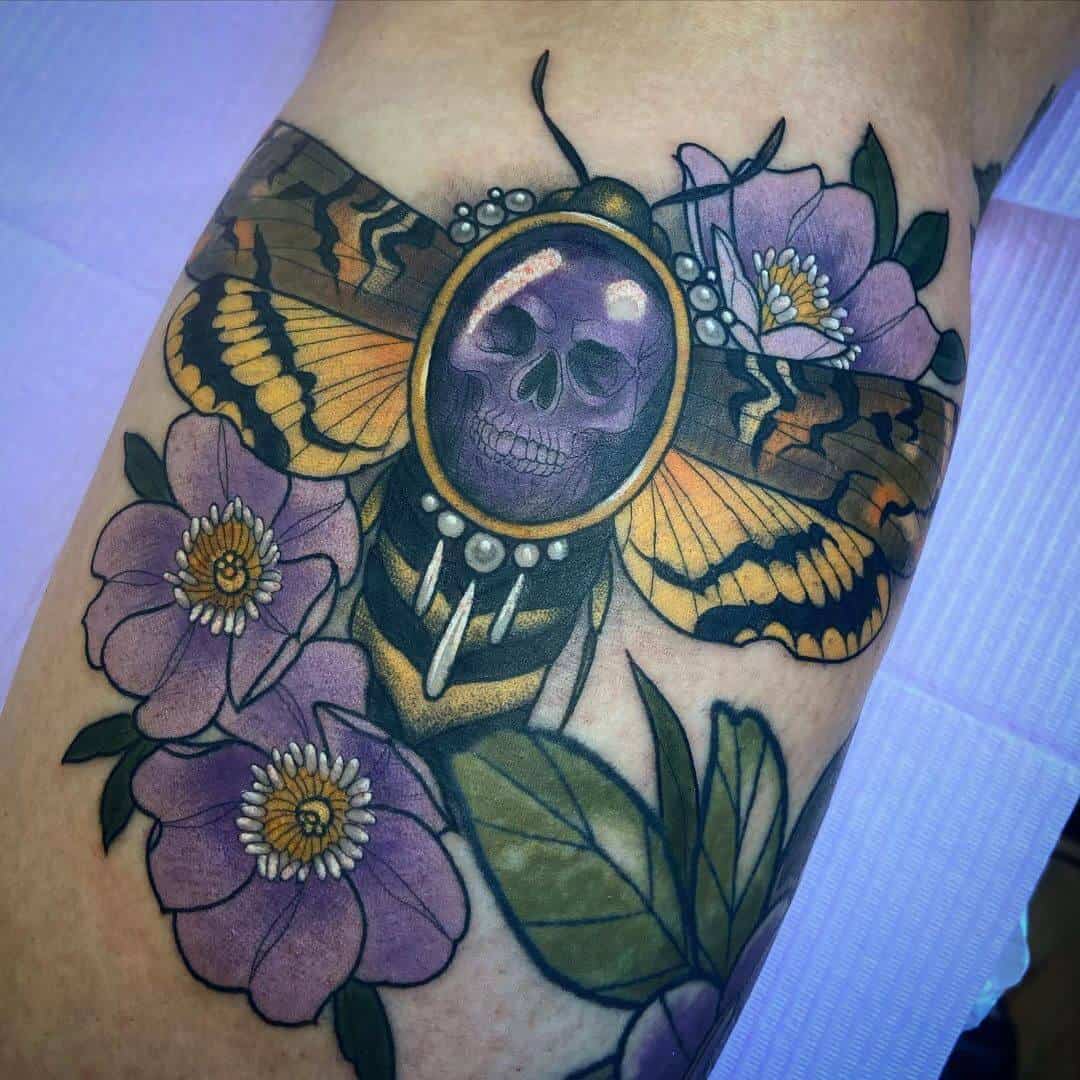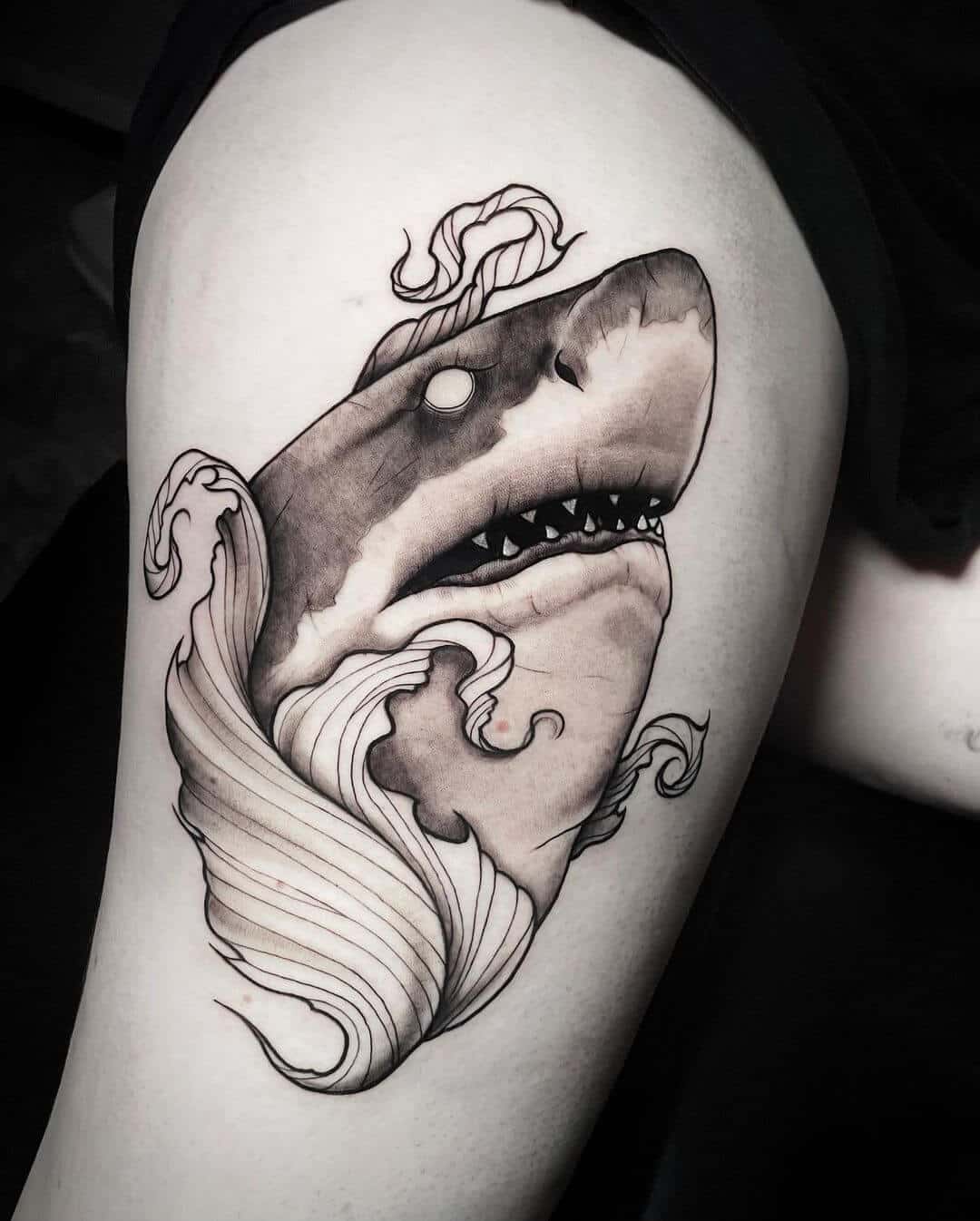Looking for some tiger tattoo ideas? In today’s guide, we showcase the best examples of tiger body art that we’ve ever seen.

Trends and fashions in tattooing come and go, but one thing remains constant: tiger body art is always popular.
In this article, we’ll explore the various meanings behind tiger art, consider some of the best tiger tattoo design ideas, and find out more about the animal itself and its cultural significance.
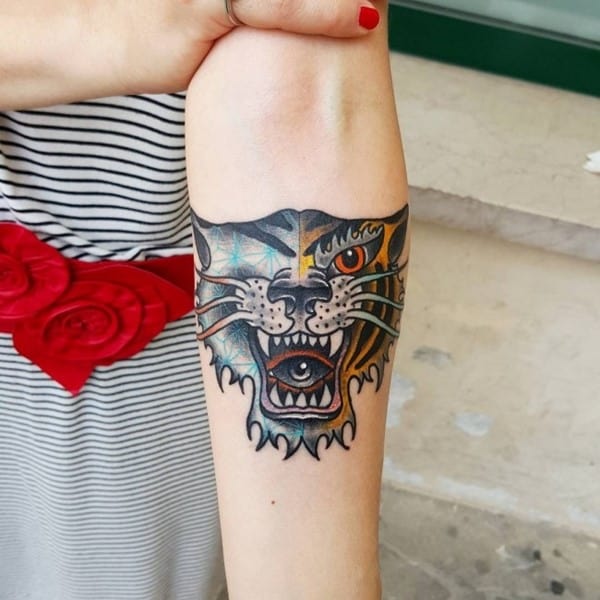
Tiger tattoo meaning
We all know it looks awesome, but what does a tiger based tattoo mean?
There are about as many meanings behind them as there are stripes on an actual tiger.
The tiger has been such a powerful symbol throughout human history and across so many cultures, that in a way, it pretty much has its own mythology.
The tiger’s main symbolic significance lies in the areas of strength, ferocity, courage, and protection.
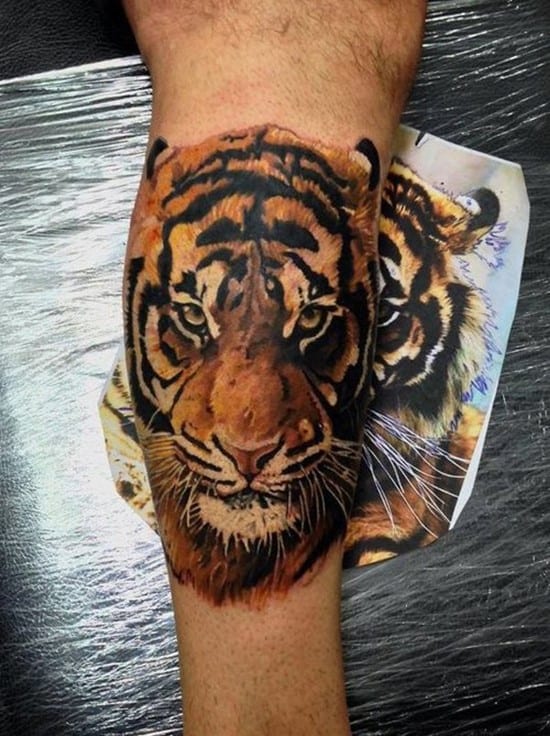
Tigers are apex predators, meaning that they are at the top of the food chain. Put simply, nothing eats tigers.
For this reason, they are often described as the ‘kings of the forest’ or ‘kings of the jungle’ and represent power, strength, and superiority.
A tattoo of a tiger, then, could be a reference to superiority and the idea of being at the top.
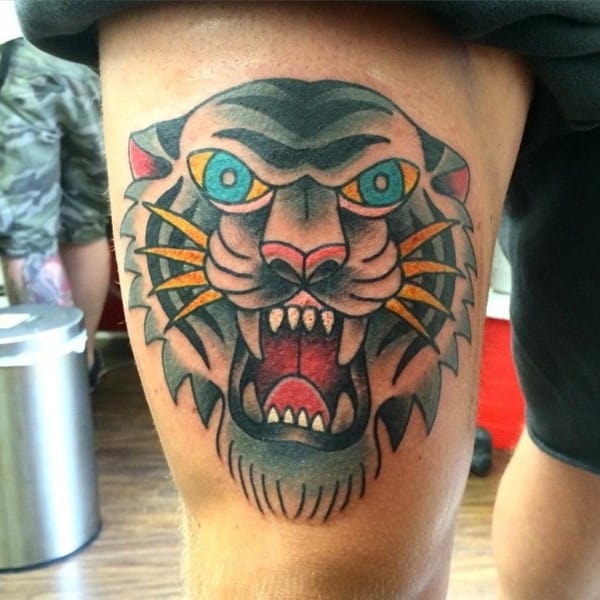
Due to their quiet strength, mastery of stalking the prey, and seemingly ‘thoughtful’ behavior, tigers are often seen as symbolic of wisdom and serenity.
A tattoo of the big cat could mean unassuming power (being strong without being arrogant), wisdom, and the importance of thinking before acting.
When tigers do attack, they are incredibly ferocious. This again reflects their strength but has also led to them sometimes being considered symbols of revenge.
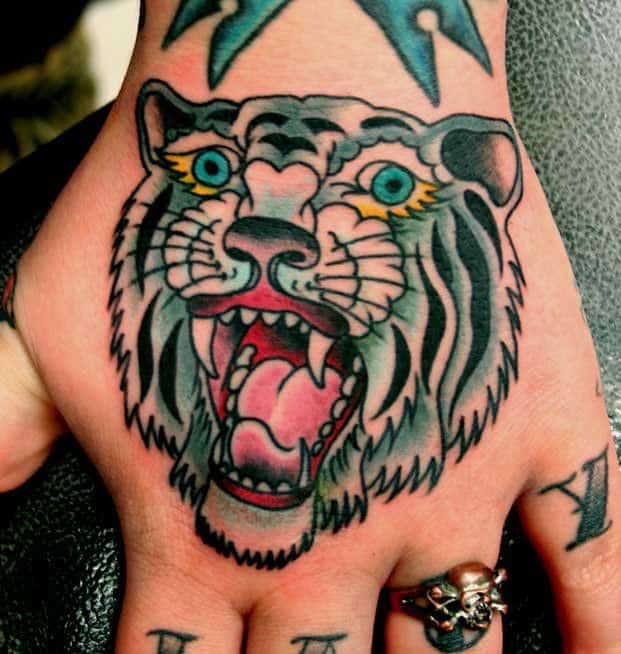
Wildlife conservation
The only threat to tigers are humans – unfortunately, we’ve hunted these animals nearly to extinction.
Tigers have been hunted by humans for their fur and fangs, sold as vanity items or superstitious charms.
Contrary to what many people believe, it’s rare for a tiger to be shot by a person in self-defense only: while they are immensely dangerous animals, they usually avoid human settlements and, under normal circumstances, don’t feed on humans.
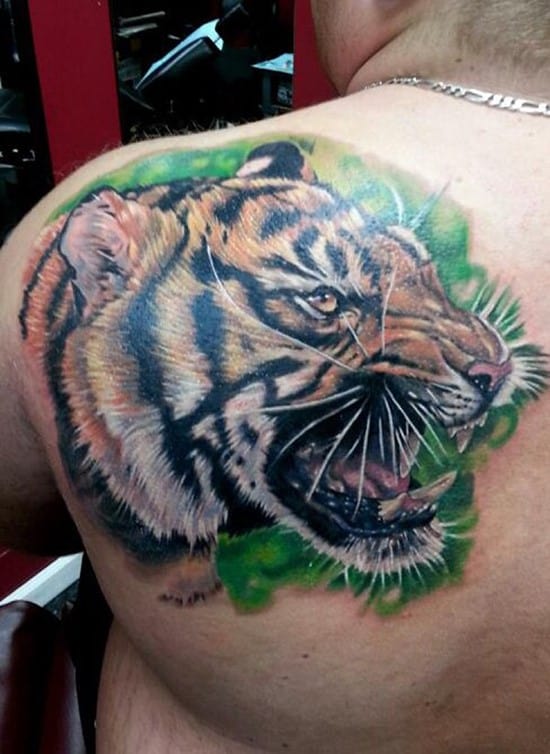
With this in mind, tiger tattoos are also sometimes symbolic of environmental conservation efforts.
Tigers are the poster-animals of many wilderness preservation organizations and campaigns.
A tiger tattoo could be a symbol of the person’s support and dedication for the cause of wildlife preservation.
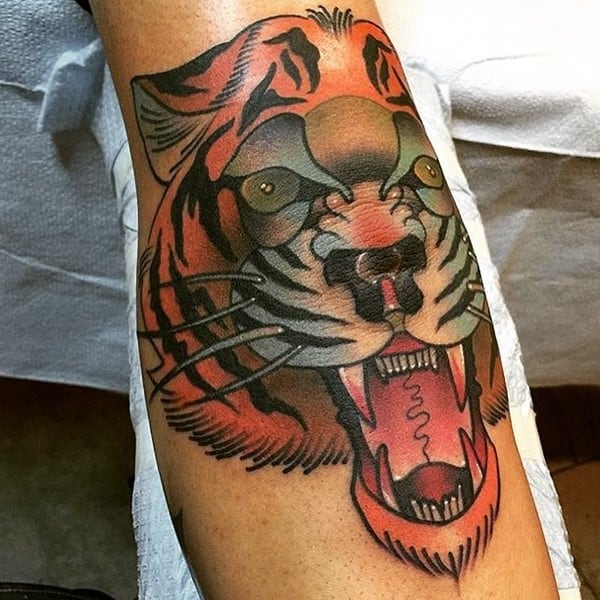
Chinese tiger tattoos
In China’s cultural context, a tiger represents courage, power, protection, dignity, and happiness, among other qualities.
The tiger is the embodiment of the positive ‘yang’ energy, and is associated with fire, summer, and the sun.
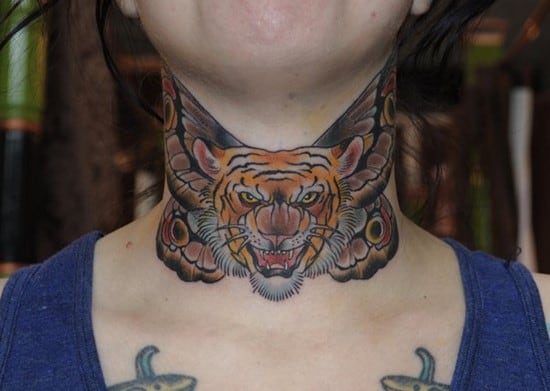
Tigers are incredibly important in Chinese culture. Chinese people have shared their land with these animals for centuries, leading to the development of a number of myths, legends, and beliefs about tigers.
In China, the tiger is a symbol of protection from supernatural threats like evil spirits, as well as more pragmatic dangers, such as fire and thieves.
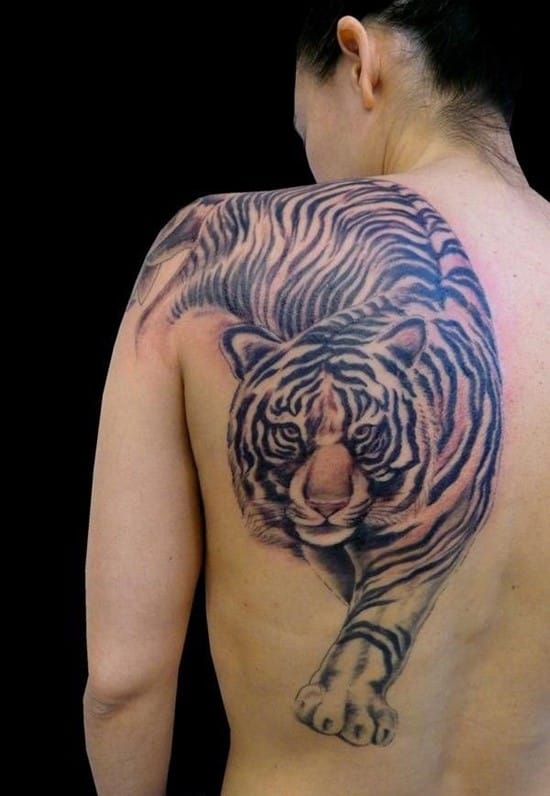
In some communities, the animal is seen as the protector of the dead. As such, depictions of the animal appear on graves. This is supposed to ensure peace for the spirits of the dead.
As well as representing the traditional qualities of strength, ferocity, and courage, tigers are also symbolic of wealth. The God of Wealth is often depicted in Asian art sitting on a tiger.
In Chinese culture, the tiger is known as the king of the beasts. Interestingly, the Chinese symbol 王, meaning ‘the king’, is linked to the pattern of stripes appearing on a tiger’s forehead.
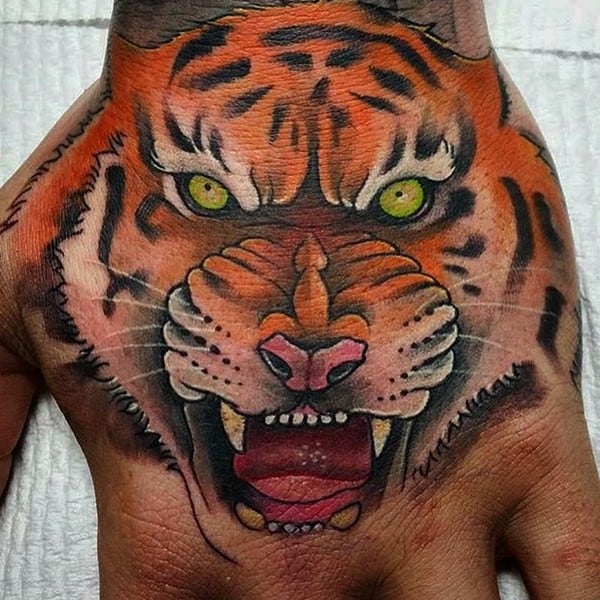
The Five Tigers
Nothing underlines the importance of tigers in Chinese culture as evidently as the myth of the five tigers.
According to the tale, these creatures are responsible for maintaining harmony in the universe and holding the balance of cosmic forces.
Each of the five tigers has a season and a set of elements ascribed to it:
- The White Tiger – Fall season, metal elements
- The Black Tiger – Winter season, water elements
- The Blue Tiger – Spring season, earth elements
- The Red Tiger – Summer season, fire elements
- The Yellow Tiger – symbolic of the Sun, ruler of all seasons and elements
When listing ideas for your tiger tattoo, you could take this myth into account and adapt the design to reflect the elements and seasons you’d like to reference.
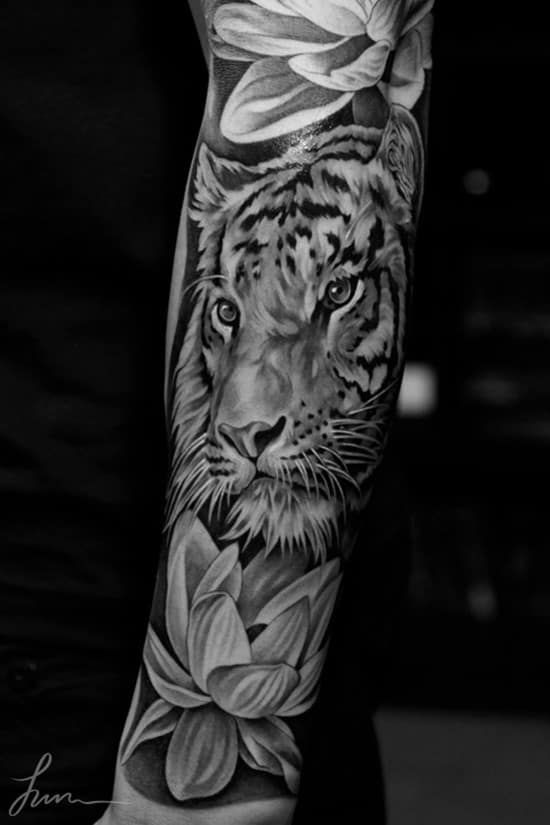
One of the frequently asked questions on the topic of tiger designs concerns the white tiger tattoo meaning.
This myth provides a partial answer – the Asian White Tiger of myth is the ruler of Fall and metal elements.
Korean tiger tattoos
Tigers are an inseparable part of traditional Korean culture and folklore – so much so that Korea was once known as the ‘Land of Tigers’.
There are so many myths and legends involving tigers in Korea that it’s difficult to narrow the animal’s meaning down to a few words. Broadly speaking, tigers in Korea represent superiority, strength, and protection.
Over the centuries, tigers have been one of the most popular subjects of the arts in Korea. It’s from these traditional folk paintings that we can draw inspiration for Korean tiger inspired tattoo work.
In particular, the way that the tiger’s face is usually rendered in this type of art is highly distinctive – so paying attention to this area when drafting a design is recommended.
Tigers in Korean art are also often depicted in the company of a magpie, so adding the bird to the tattoo design will make it an unmistakable reference to Korean folk traditions.
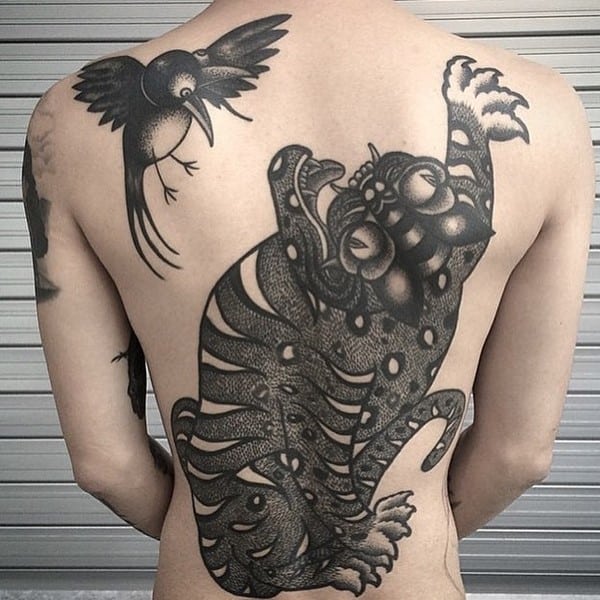
The National Museum of Korea has made its exhibition on the Korean Tiger publicly available.
Here, you can see examples of traditional Korean tiger art to inspire your authentic Korean tiger tattoo design.
Popular tiger tattoo designs
Tigers are such versatile symbols that the possibilities for tattoo designs are virtually endless.
Here, we’ve compiled a list of the most popular tiger body art designs and styles to guide and inspire you.
Traditional tiger tattoos
The traditional style of tattooing involves a black outline filled with mostly solid colors.
There is little shading, and the aim is not so much realism as fitting in with the classic, retro tattoo look.
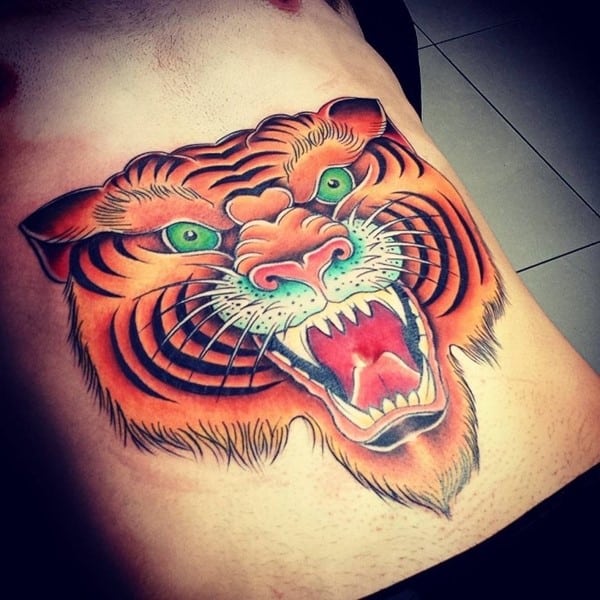
These tattoos in the traditional style will usually be placed on the shoulder, arm, or back. For women, the thigh is also a common placement.
3D tiger tattoos
The 3D style, unlike the traditional tattoos described above, aims for full realism.
Artists use careful shading, gentle outlines, and perspective to create a hyper-realistic image.
Photographs are usually taken as a reference, and the tattoo needs to match the photograph as closely as possible.
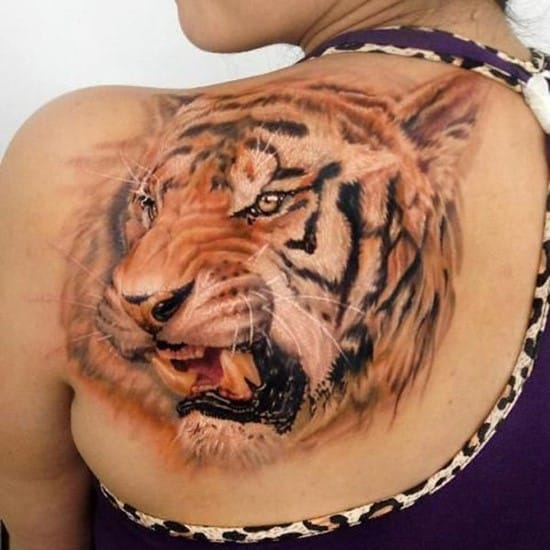
Both color and black-and-gray options make for great tattoos. The appearance of a tiger – especially the element of the stripes – is so distinctive that even in black ink, the animal will be instantly recognizable.
When deciding to get a 3D tattoo, it’s important to choose an artist experienced in this style. 3D tattooing is notoriously difficult, and even slight mistakes can be enough to skew the perspective and miss the desired effect entirely.
Therefore, find an artist with a great 3D portfolio, preferably with experience in tattooing animals.
Another thing to keep in mind in regards to 3D tattoos is that for a tiger, the design will need to be fairly large. Creating depth and perspective requires space, especially for subjects with lots of small details – like the tiger.
The tattoo won’t necessarily need to take up your entire back, but don’t expect to fit a well-rendered 3D tattoo onto a really small space, like your wrist.
Watercolor tiger tattoo
Popular especially among women, the watercolor style aims to imitate the look of a watercolor painting. In this style, the entire tattoo can be rendered in this way, or black outlines may be added for more definition.
For watercolor tiger tattoos, there’s a definite trend towards semi-abstract designs, using colors that don’t naturally appear on a tiger.
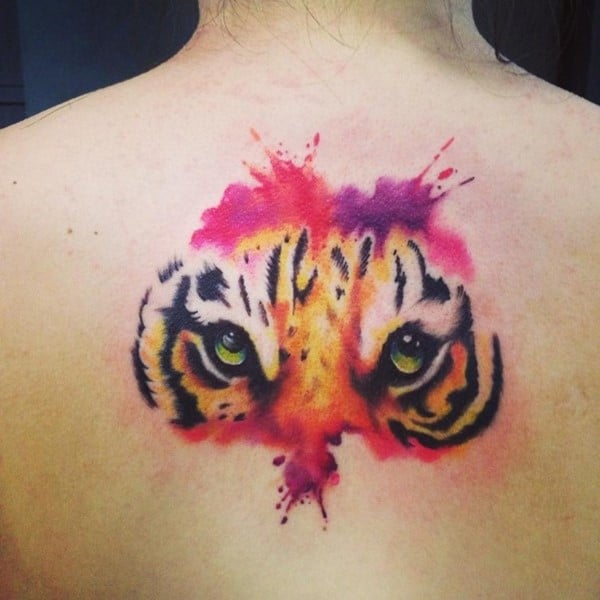
The use of abstract colors blending together, either as fill for the silhouette of the tiger or as background, adds a supernatural, cosmic look to the design.
This makes the tattoo look even more extraordinary and unique, as well as underlining the personal symbolic meanings of the design.
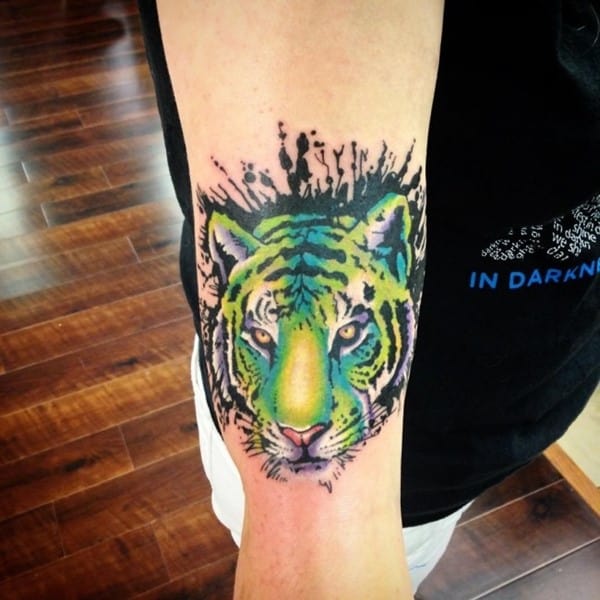
White tiger tattoo
We’ve already mentioned white tigers in connection to the Chinese myth of the Five Tigers and their elements – where the white tiger rules over Fall and metal elements.
White tigers are not just mythical creatures: although they are extremely rare, they do exist in nature – or, to be more precise, primarily in captivity.
These are Bengal tigers that, due to a gene mutation, don’t have the orange pigmentation in their fur. Their stripes range in color from dark brown to almost white, and their eyes are usually blue or amber.
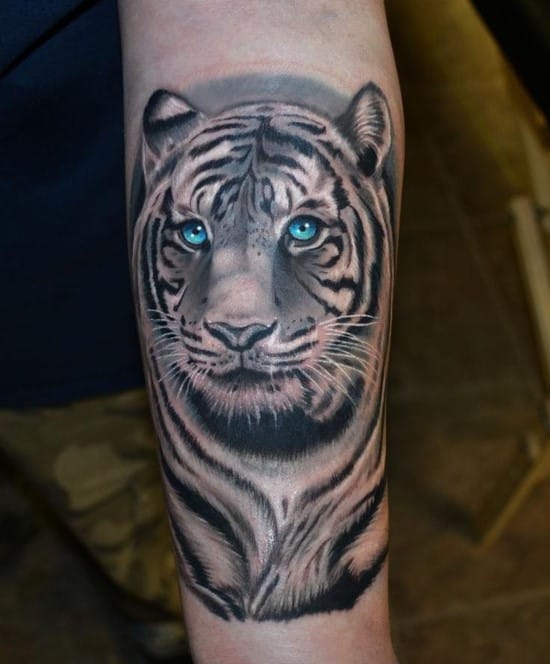
Due to their rarity, white tigers symbolically represent the extraordinary, the unique, and the uncommon. Other than this added layer of meaning, their significance is the same as that of orange tigers.
A white tiger in a tattoo design can look indistinguishable from a ‘normal’ tiger in grayscale. When designing a white tiger tattoo, it’s important to pay attention to how it will be made clear that the tiger in the image is indeed white.
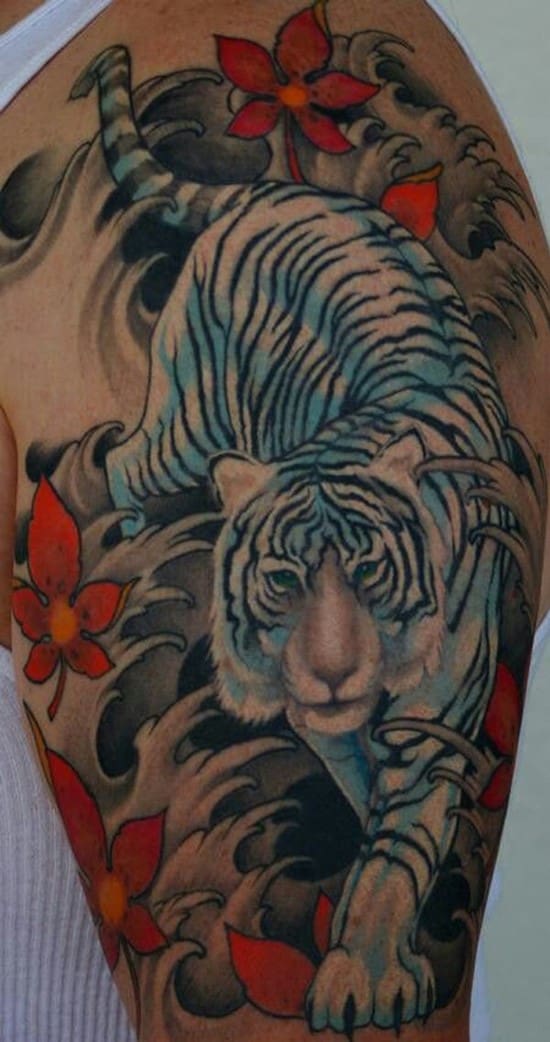
One way is to make the eyes of the tiger a focal point – only white tigers have blue eyes. Another technique involves adding some background elements (realistic or abstract) in color to provide a contrast for the white fur of the tiger.
Tiger with crown tattoo
Looking through our gallery below, you’ll see plenty of examples of designs involving a tiger’s head with a crown upon it.
This design is a reference to the idea of the tiger as the ‘king of the jungle’ – the apex predator, ruling over the animal kingdom and living without fear of attack.
The crown is an obvious status symbol, signifying power, authority, and belonging to the very top of the elite.
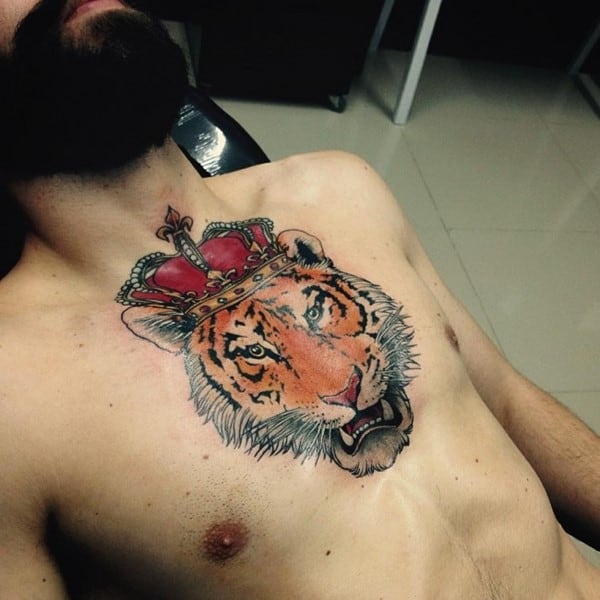
The chest is a common placement for this design among men, where it makes for an impressive piece. The chest allows for a large rendition of the tiger.
This part of the body also bears an association with the concepts of pride and self-expression, so symbolically it’s a fitting match.
Tiger back tattoo
For many people, the idea of a tiger tattoo immediately brings traditional Japanese full-back tattoos to mind. There’s a good reason for that: tigers are a common subject of this branch of tattooing.
When rendered on the full-back in Japanese style, the tiger will usually be accompanied by other elements – one of the defining features of Japanese tattoos is the presence of multiple subjects. These tend to originate from nature.

Tigers are often combined with other animals or mythical creatures such as bears, lions, and dragons. Waves are also a common element in Japanese tattoo art, as are flowers and other plants. The tattoos are usually done in full color.
The tiger back tattoo doesn’t necessarily need to fit this style or cover the whole back, though.
These types of attoos placed on the shoulder (top left or top right quadrant of the back) are a popular choice.
This space is large enough to allow for a 3D image, particularly if the design only involves the animal’s head.
Black tiger tattoos
For a more contemporary feel and a more delicate look, consider a tiger image done in black ink and composed mainly of outlines.
The lack of coloring and fill makes the tattoo somewhat less eye-catching, but it also lends it a modern feel and makes it easier to combine with other (future or existing) tattoos.
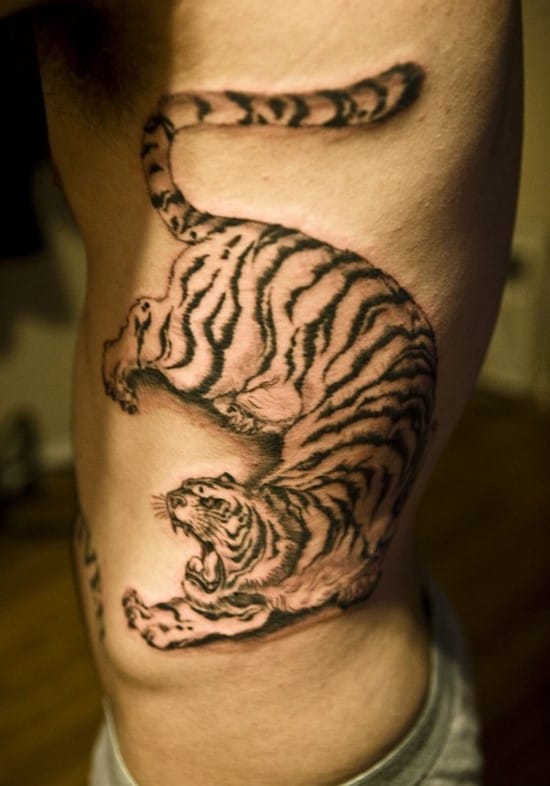
The side of the chest (along the ribs) is one of the most popular placements for contemporary, black outline tiger tattoos. The back and the arm are also often chosen as the site for this design.
Final words
Whether you’re drawn to tiger body art due to their meaning of power and strength, an affinity for the animal, or simply because you enjoy the way they look, one thing’s for sure: tiger inspired tattoo work is here to stay.
They haven’t gone out of fashion for decades – in the case of Japanese body art, even centuries – and they’re not going to do so anytime soon.
Below, you’ll find a huge gallery of tiger designs to guide and inspire you as you choose your own design. Don’t forget to let us know your favorites in the comments!
